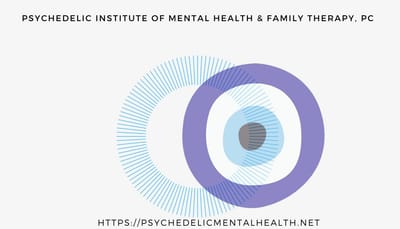Neural correlates and subjective experiences in meditation vs psychedelics, including ketamine (Preliminary Lit Review)


(2025) We synthesized evidence on KT-induced oscillatory and connectivity changes in healthy volunteers (HVs), major depressive disorder (MDD) and treatment-resistant depression (TRD), relating neural signatures to symptomatic relief.
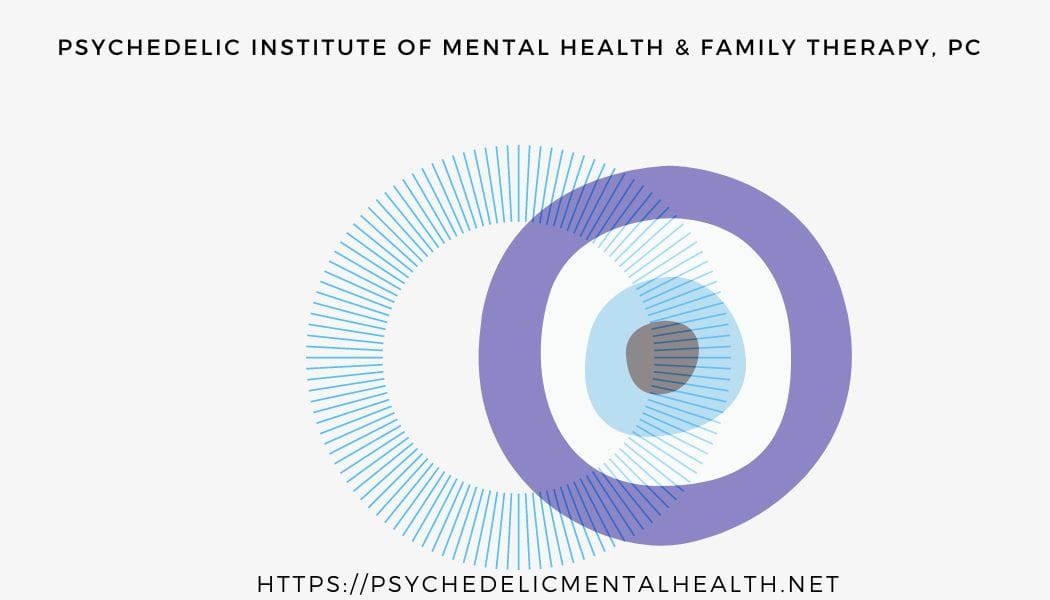
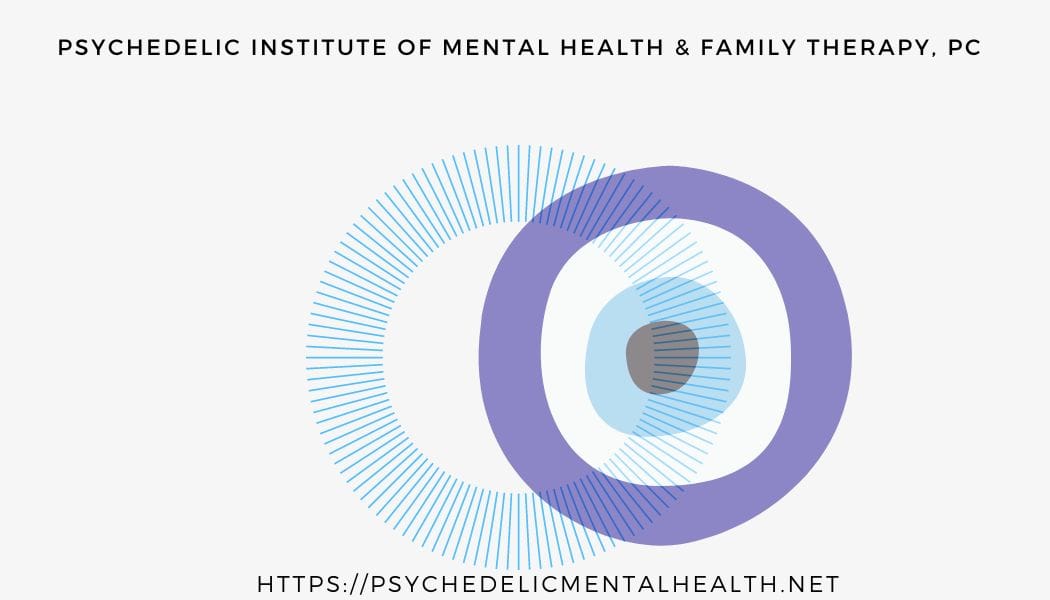
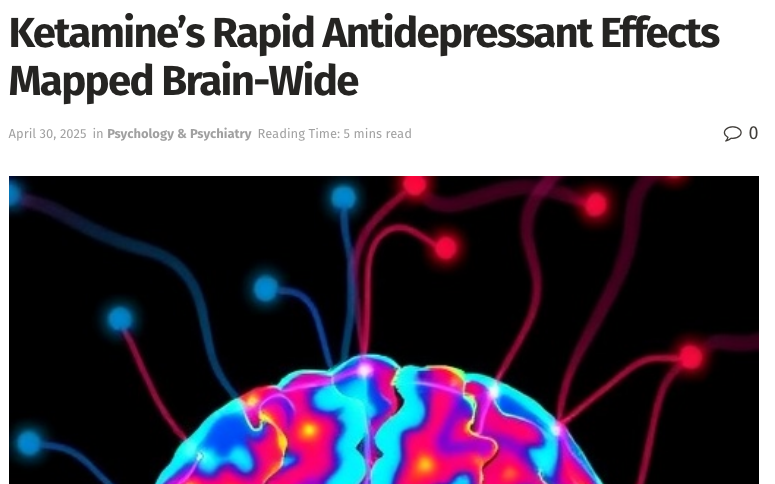
"The deployment of mesoscale brain-wide fluctuation analysis unveils the complex, multiregional neural orchestration underlying ketamine’s rapid antidepressant effects, a blueprint for future therapeutic innovation... insights gained from this research hold transformative promise..."
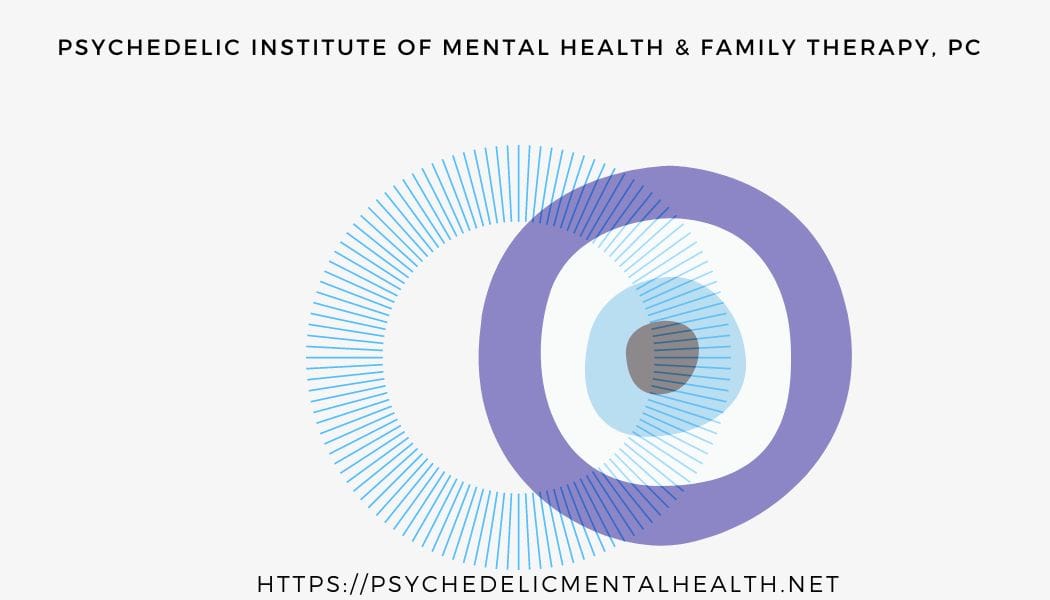
Meditation and psychedelics facilitate similar types of mystical, psychological, and philosophical-existential insights predictive of wellbeing: a qualitative-quantitative approach (Jylkkä, et al, 2025)

"the reported insights were highly similar across the two types of reports, and only minor differences were observed between classic and non-classic psychedelics. Regression analyses indicated that metacognitive and value insights were positively associated with perceived improvements in positive affect, while mystical-type insights predicted increased meaning in life. These findings suggest that both psychedelic substances and meditation can facilitate a broad range of insights that are not fully captured by existing questionnaires. The results highlight similarities between psychedelic and meditation experiences supporting the notion that transformative experiences are not exclusive to classic psychedelics but can be facilitated through various means."
When synaptic firing in the brain deteriorates due to inflammation, aging, or other factors, brain networks can become disrupted, affecting thoughts of self and others, mood, behavior, and physical responses. Research on psychedelic medicine suggests that substances like ketamine can compensate for this misfiring, but the brain may still experience issues in the future. Cognitive behavioral therapy and ongoing meditation practices have shown promise in addressing these neural deficits, either alone or in combination with psychedelic treatments like ketamine.
Studies have found commonalities in brain networks, such as the Default Mode Network and the Salience Network, between psychedelic experiences and those induced by meditation. Biomarkers for synaptic deficits are being established, and treatment pathways are being developed. Ketamine has been shown to provide rapid relief for many individuals with depression, and researchers are exploring its potential for various off-label indications. Psychedelics like psilocybin have been studied by Western science for over 100 years, with some repurposed medicines and new applications currently undergoing FDA review.
We propose Akrasia as a psychological representation of this degradation in neural connections and firing, as treated by the neuroplastic properties of medicines such as ketamine and other psychedelics, which seem to elicit a common experience in people during acute treatment with the medicine compounds. Similar experiences are also reported by individuals who practice meditation, a tool that may also be used in treating and maintaining overall health in individuals experiencing Akrasia. Research and practice are ongoing


Psychological phenomena and the electroencephalogram (Lindsley, 1952)
https://www.sciencedirect.com/science/article/abs/pii/0013469452900758
EEG Correlates of Stages of Meditative Quiescence: a Pilot Study (McFarlane, 2004)
The relationship between EEG measurements and meditation was first investigated in the 1950s and 1960s. Although the differences between various meditative practices must be taken into account, these studies generally suggest that increased alpha and theta activity is strongly correlated with most meditative states of mind. Of particular relevance to the present paper is the study of advanced zazen meditators by Hirai (1974). Four EEG stages were identified in meditation sessions: (1) initial appearance of alpha, (2) increased alpha, (3) decrease in alpha, (4) increased rhythmical theta (bursts of 6-7 Hz primarily in central locations). The presence of these distinct phases of the objective EEG data suggest that there may be distinct subjective states that correspond to these phases during the meditation session. It is the purpose of this pilot study to experimentally explore this question.

2008
This article focuses on both daily forms of weakness of will as discussed in the philosophical debate (usually referred to as akrasia) and psychopathological phenomena as impairments of decision making. We argue that both descriptions of dysfunctional decision making can be organized within a common theoretical framework that divides the decision making process in three different stages: option generation, option selection, and action initiation. We first discuss our theoretical framework (building on existing models of decision-making stages), focusing on option generation as an aspect that has been neglected by previous models. In the main body of this article, we review how both philosophy and neuropsychiatry have provided accounts of dysfunction in each decision-making stage, as well as where these accounts can be integrated. Also, the neural underpinnings of dysfunction in the three different stages are discussed. We conclude by discussing advantages and limitations of our integrative approach.
Buddha's Brain: Neuroplasticity and Meditation (Davidson, 2008)
https://onlinelibrary.wiley.com/doi/book/10.1002/9781119171690
Previous studies [6] of high-amplitude pattern of gamma synchrony in expert meditators during an emotional version of OM meditation support the idea that the state of OM may be best understood in terms of a succession of dynamic global states. Compared to a group of novices, the adept practitioners self-induced higher-amplitude sustained electroencephalography (EEG) gamma-band oscillations and long-distance phase synchrony, in particular over fronto-parietal electrodes, while meditating. Importantly, this pattern of gamma oscillations was also significantly more pronounced in the baseline state of the long-term practitioners compared with controls, suggesting a transformation in the default mode of the practitioners ... Although the precise mechanisms are not clear, such synchronizations of oscillatory neural discharges may play a crucial role in the constitution of transient networks that integrate distributed neural processes into highly ordered cognitive and affective functions.
An example of high-amplitude gamma activity during a form of OM meditation, non-referential compassion meditation, in long-term Buddhist practitioners...
The intra-individual analysis on the ratio of gamma to slow oscillations (4–13 Hz) averaged across all electrodes during compassion meditation...

2008
We found evidence that cognitive processes can also involve the disruption of gamma-band activity in high-order brain regions. Intracerebral electroencephalograms were recorded in 3 epileptic patients during 2 reading tasks. Visual presentation of words induced a strong deactivation in a broad (20-150 Hz) frequency range in the left ventral lateral prefrontal cortex, in parallel with gamma-band activations within the reading network, including Broca's area. The observed energy decrease in neural signals was reproducible across patients.

(2008)
In conclusion, ketamine evokes abnormal perceptual experiences and dissociation by increasing glutamate release. The latter results in (1) aberrant perceptual processing in a network of auditory and visual association cortices centered on mid-posterior cingulate and (2) focal suppression of the OFC/subgenual cingulate and temporal pole (BA38), which prevents integration of aberrant percepts with visceromotor function and the sense of self. These mechanisms suggest a neural basis for the splitting of mental functions or schizophrenia that Bleuler61 proposed gave rise to the “fundamental symptoms” of the disorder. These findings also suggest that ketamine-induced suppression of OFC/subgenual cingulate function may mediate antidepressant effects by disconnecting the excessive effect of an aversive visceromotor state on cognition and the self in depression. It would seem an important research priority to determine how ketamine suppresses ventromedial frontal neuronal function.

2012 Review of the literature:
The distinction between processes used to perceive and understand the self and others has received considerable attention in psychology and neuroscience. Brain findings highlight a role for various regions, in particular the medial prefrontal cortex (mPFC), in supporting judgments about both the self and others. We performed a meta-analysis of 107 neuroimaging studies of self- and other-related judgments using Multilevel Kernel Density Analysis (MKDA; Kober & Wager, 2010). We sought to determine what brain regions are reliably involved in each judgment type, and in particular, what the spatial and functional organization of mPFC is with respect to them. Relative to non-mentalizing judgments, both self and other judgments were associated with activity in mPFC, ranging from ventral to dorsal extents, as well as common activation of the left temporoparietal junction (TPJ) and posterior cingulate. A direct comparison between self and other judgments revealed that ventral mPFC (vmPFC), as well as left ventrolateral PFC and left insula, were more frequently activated by self-related judgments, whereas dorsal mPFC (dmPFC), in addition to bilateral TPJ and cuneus, were more frequently activated by other-related judgments. Logistic regression analyses revealed that ventral and dorsal mPFC lay at opposite ends of a functional gradient: the z-coordinates reported in individual studies predicted whether the study involved self- or other-related judgments, which were associated with increasingly ventral or dorsal portions of mPFC, respectively. These results argue for a distributed rather than localizationist account of mPFC organization and support an emerging view on the functional heterogeneity of mPFC.

(Icaza, et al, 2013)
The psychedelic experience has been reported since antiquity, but there is relatively little known about the underlying neural mechanisms. A recent neuroimaging study on psilocybin revealed a pattern of decreased cerebral blood flow and functional disconnections that is surprisingly similar to that caused by various anesthetics. In this article, the authors review historical examples of psychedelic experiences induced by general anesthetics and then contrast the mechanisms by which these two drug classes generate altered states of consciousness.

2013
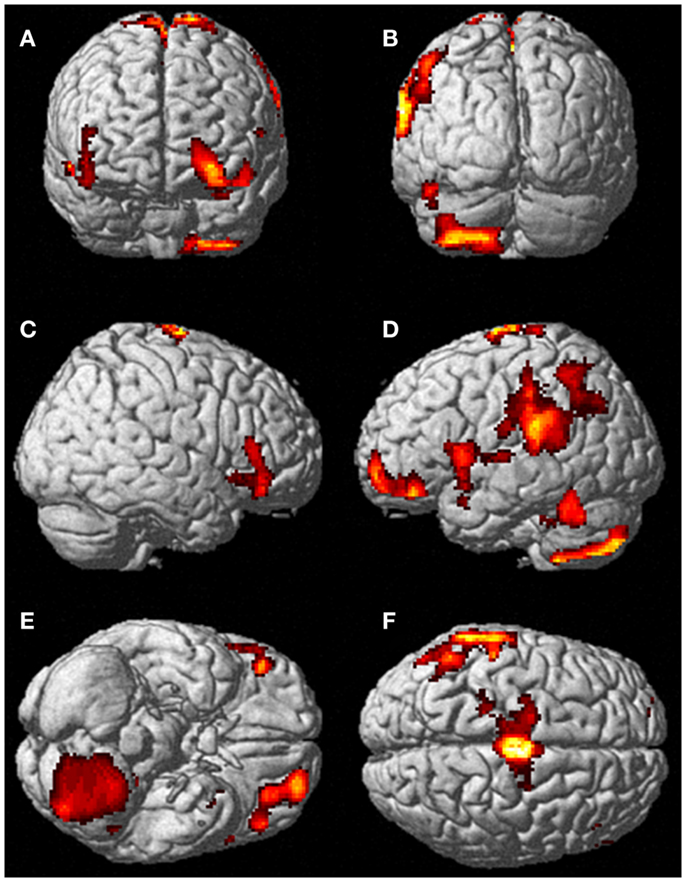
2014 study using fMRI during out of body experience. Studies such as this establishes a comparison to experiences under similar conditions with meditation as well as psychedelic medicine practice, including ketamine.
The neuroscientific study of spiritual practices (Newberg, 2014)
https://www.ncbi.nlm.nih.gov/pmc/articles/PMC3957224/
Ketamine Psychedelic Psychotherapy: Focus on its Pharmacology, Phenomenology, and Clinical Applications (Kolp, et al, 2014)
See Kolp, 2014 Table 1 - Ketamine-induced non-ordinary states of consciousness, p 93

In meditative traditions, the purpose of drawing attention away from the outside world and abandoning habitual patterns of perceiving and thinking is to facilitate personal change. The focused attention, self-forgetfulness, and heightened awareness of body states are supposed to open the mind to decreased preoccupation with one's own suffering, a move from self-deception to self-understanding, and resulting changes in attitudes and behavior.
The resemblance to the aims of psychotherapy is no accident, as practitioners of both traditions increasingly recognize. But the psychotherapeutic tradition now taking meditation most seriously, to the surprise of some, is cognitive behavioral therapy.

2015
The experiences induced by psychedelics share a wide variety of subjective features, related to the complex changes in perception and cognition induced by this class of drugs. A remarkable increase in introspection is at the core of these altered states of consciousness. Self-oriented mental activity has been consistently linked to the Default Mode Network (DMN), a set of brain regions more active during rest than during the execution of a goal-directed task. Here we used fMRI technique to inspect the DMN during the psychedelic state induced by Ayahuasca in ten experienced subjects. Ayahuasca is a potion traditionally used by Amazonian Amerindians composed by a mixture of compounds that increase monoaminergic transmission. In particular, we examined whether Ayahuasca changes the activity and connectivity of the DMN and the connection between the DMN and the task-positive network (TPN). Ayahuasca caused a significant decrease in activity through most parts of the DMN, including its most consistent hubs: the Posterior Cingulate Cortex (PCC)/Precuneus and the medial Prefrontal Cortex (mPFC). Functional connectivity within the PCC/Precuneus decreased after Ayahuasca intake. No significant change was observed in the DMN-TPN orthogonality. Altogether, our results support the notion that the altered state of consciousness induced by Ayahuasca, like those induced by psilocybin (another serotonergic psychedelic), meditation and sleep, is linked to the modulation of the activity and the connectivity of the DMN.
EEG Derived Neuronal Dynamics during Meditation: Progress and Challenges (Kaur & Singh, 2015)
https://www.ncbi.nlm.nih.gov/pmc/articles/PMC4684838/

2015
Over the past decade mind and body practices, such as yoga and meditation, have raised interest in different scientific fields; in particular, the physiological mechanisms underlying the beneficial effects observed in meditators have been investigated. Neuroimaging studies have studied the effects of meditation on brain structure and function and findings have helped clarify the biological underpinnings of the positive effects of meditation practice and the possible integration of this technique in standard therapy. The large amount of data collected thus far allows drawing some conclusions about the neural effects of meditation practice. In the present study we used activation likelihood estimation (ALE) analysis to make a coordinate-based meta-analysis of neuroimaging data on the effects of meditation on brain structure and function. Results indicate that meditation leads to activation in brain areas involved in processing self-relevant information, self-regulation, focused problem-solving, adaptive behavior, and interoception. Results also show that meditation practice induces functional and structural brain modifications in expert meditators, especially in areas involved in self-referential processes such as self-awareness and self-regulation. These results demonstrate that a biological substrate underlies the positive pervasive effect of meditation practice and suggest that meditation techniques could be adopted in clinical populations and to prevent disease.
Core Principles of Meditation for Therapy: Improving the Outcomes of Psychotherapeutic Treatments (Simpkins & Simpkins, 2016)
summary "The Changing Self"
https://onlinelibrary.wiley.com/doi/10.1002/9781119171690.ch2
The brain undergoes change all through life, and meditation is a method to activate positive brain change. This process of brain change occurs through neuroplasticity and neurogenesis. Brain development is a continual exchange between inborn genetics and environmental influences, beginning from conception and continuing all through the developmental process. Many of the meditative practices taught in this book can help to correct deficits in these primary skills of vision, movement, and language. Adolescence is a time for dramatic brain changes, and meditation can help make these changes flow better. The changes occur first in the posterior areas of the sensory and motor cortex. The result is that adolescents often develop sensory and motor skills, expressed in artistic talent and athletic ability. Perceiving change is an ability to construct a reality from cues in the environment has a significant application to psychotherapy.

The Neural Mechanisms of Meditative Practices: Novel Approaches for Healthy Aging (Acevedo, et al, 2016)
https://www.ncbi.nlm.nih.gov/pmc/articles/PMC5110576/
Results from our review showed a pattern of neural regions that are consistently affected across meditation studies, namely areas involved in reward, motivation, and learning (the striatum); attention and memory (ACC, thalamus, and hippocampus); and sensory integration (insula), self-regulation (orbitofrontal cortex), and the DMN (PCC, precuneus, and TPJ). Common activations also appeared in the IFG, an area that is known for its role in empathy and language processing [49–51], and the fusiform gyrus, an area implicated in the recognition and process of faces [52] and more generally the recognition of objects that are salient or evocative in some way [53]. Also, the somatomotor cortex is involved in the sensory representation and the coordination of motor activities [54]. Collectively, these areas are targets of degeneration in healthy aging but also in other disorders. For example, a review of research studies by Mohan et al. (2016) showed that the DMN is disrupted in AD, PD, epilepsy, attention deficit hyperactivity disorder (ADHD), and mood disorders [33]. Another review of research found that connectivity and network integrity of the DMN decrease in healthy aging, but at a much more rapid pace in AD [55].
In combination with other research, results from the present review suggest that meditative practices commonly affect brain systems involved in attention, memory, conscious awareness, reward, and emotional regulation that are important and can be disrupted by cerebrovascular and neurodegenerative changes. Thus, as suggested by previous reviews, meditation may enhance cognitive and psychological health via neuroplastic effects on brain structures and circuits that influence attention, memory, and emotional regulation. Although these findings do not support stress buffering and relief models of meditation and yoga, it is likely that enhancement of these functions may indirectly alleviate stress. For example, by exerting greater self-control, individuals may better regulate their thoughts and emotions, thus possibly resulting in adaptive responses to stress.

(2017)
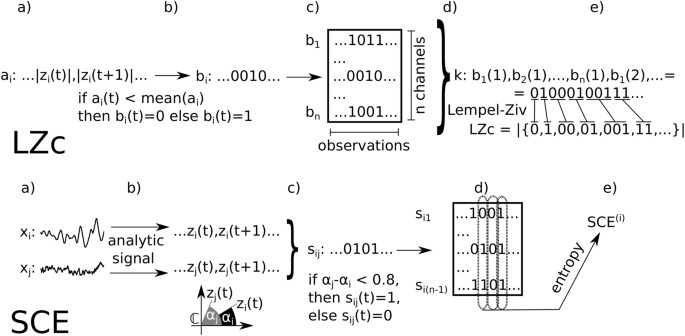
“…WE FOUND A CLEAR INCREASE IN SIGNAL DIVERSITY FOR ALL THREE PSYCHEDELIC AGENTS AT THE GROUP LEVEL, WITH EFFECTS BEING STRONGEST FOR KET. THESE INCREASES WENT BEYOND THOSE EXPECTED FROM THE CHANGES TO THE FREQUENCY SPECTRUM.”

In 2017:
CBT for depression may disrupt MPFC-ACC connectivity, with associated improvements in depressive symptoms and dysfunctional cognition.

Ketamine has been used as a pharmacological model for schizophrenia as subanesthetic infusions have been shown to produce temporary schizophrenia-like symptoms in healthy humans. More recently, ketamine has emerged as a potential treatment for multiple psychiatric disorders, including treatment-resistant depression and suicidal ideation. However, the mechanisms underlying both the psychotomimetic and the therapeutic effects of ketamine remain poorly understood. This review provides an overview of what is known of the neural mechanisms underlying the effects of ketamine and details what functional MRI studies have yielded at a systems level focused on brain circuitry. Multiple analytic approaches show that ketamine exerts robust and consistent effects at the whole-brain level. These effects are highly conserved across human and nonhuman primates, validating the use of nonhuman primate models for further investigations with ketamine. Regional analysis of brain functional connectivity suggests that the therapeutic potential of ketamine may be derived from a strengthening of executive control circuitry, making it an intriguing candidate for the treatment of drug abuse. There are still important questions about the mechanism of action and the therapeutic potential of ketamine that can be addressed using appropriate functional neuroimaging techniques.

(2018)
Specific mental training cultivates diminished self-reference, encompassing non-duality, emptiness, awakened-awareness, and compassionate experiences. We aimed to elucidate the neural substrates of four distinct, interdependent Essence-of-Mind states: (1) timelessness, (2) non-preference, non-duality, non-conceptualization, (3) the view of luminosity and limitlessness, (4) unified compassionate experience of oneness (stable awakened-awareness). EEG data were collected from 30 advanced meditators concomitant to eyes-open/eyes-closed resting baseline, followed by 60-min of instructed practice. Alpha, beta, and gamma, frequency-spatial EEG-dimensions were analyzed. The results revealed that compared to baseline, current density across frequencies significantly decreased upon meditation onset in self-referential, and executive-control regions. During meditation, gamma-band current density significantly increased from state-1 compared to state-4, within the ACC, precuneus, and superior parietal lobule, whereas beta-band activity increased within the insula. These findings suggest a dissociation between brain regions regulating self-referential vs. executive-control processing, during non-dual, compassionate states, characterized by brilliantly awake awareness, free from conceptual thought and "doing".
Ketamine-Associated Brain Changes: A Review of the Neuroimaging Literature (Ionescu, 2018)
https://www.ncbi.nlm.nih.gov/pmc/articles/PMC6102096/
Analysis of resting state scans in healthy volunteers further suggests that dissociation may be responsible for ketamine’s antidepressant effects because it may disconnect the excessive aversive visceromotor state on cognition and self—a hallmark of depression.40 Related, one study found that ketamine may dampen brain regions involved in rumination via reduction of the functional connectivity between the pACC and the dPCC.42 Ketamine also disrupts the “hyperconnectivity” of the DMN (e.g., by decreasing connectivity between the mPFC and DMN) found in patients with MDD. DMN hyperconnectivity is commonly associated with increased rumination.31,44 This study also found decreased connectivity between the left and right executive control networks, which are involved in internal and external sensory processing.65 One ongoing study (ClinicalTrials.gov ID: NCT02544607) aims to investigate this further in patients with TRD before and after a ketamine infusion. In other words, these studies suggest that ketamine causes a “disconnect” in several circuits related to affective processing, perhaps by shifting focus away from the internal states of anxiety, depression, and somatization and more towards the perceptual changes induced by ketamine. Similarly, during an emotional task, ketamine attenuated responses to negative pictures, suggesting that the processing of negative information is specifically altered in response to ketamine.50 By taking the focus off of “oneself” and placing the focus on other stimuli, perhaps ketamine decreases awareness during negative experiences.
Perhaps most interesting is ketamine’s effects on brain connectivity as it relates to self-monitoring behaviors. Reduced connectivity between the pACC and dPCC was associated with increased dissociation during infusion, and reduced activation in the left superior temporal cortex was associated with impaired self-monitoring.42, 54 Such self-monitoring is disruptive to patients with psychotic illness—especially those with chronic symptoms of psychosis. However, perhaps the transient dissociation experienced by depressed patients during a ketamine infusion is essential for dampening what could be considered as hyperactive self-monitoring that results from depressive illness.
A Neurotheological Perspective on Altered States of Consciousness (PDF) (2018)

Short-term training, compared to the control intervention, also led to increased functional connectivity between the amygdala and a region implicated in emotion regulation – ventromedial prefrontal cortex (VMPFC) – during affective pictures. Thus, meditation training may improve affective responding through reduced amygdala reactivity, and heightened amygdala–VMPFC connectivity during affective stimuli may reflect a potential mechanism by which MBSR exerts salutary effects on emotion regulation ability.

(2019) We conducted a longitudinal functional MRI study to test the hypothesis that the pain-relieving effect of ketamine is the result of reversal of abnormalities in regional low-frequency brain oscillations (LFOs) and abnormal cross-network functional connectivity (FC) of the dynamic pain connectome. We found that (1) ketamine decreased regional LFOs in the posterior cingulate cortex of the default mode network, (2) a machine-learning algorithm demonstrated that treatment-induced brain changes could be used to make generalizable inferences about pain relief, (3) treatment responders exhibited a significant decrease in cross-network static FC between the posterior cingulate cortex and regions of the sensorimotor and salience networks following treatment, (4) the degree of reduced cross-network FC correlated with the amount of pain relief, and (5) ketamine treatment did not produce significant differences in static or dynamic FC within the ascending nociceptive or descending antinociceptive pathway. These findings support the proposition that regional LFOs contribute to cross-network connectivity that underlie the effectiveness of ketamine to produce significant relief from neuropathic pain. Together with our recent findings that pretreatment dynamic FC of the descending antinociceptive pathway can predict ketamine treatment outcomes, these new findings indicate that pain relief from ketamine arises from a combination of flexible pretreatment FC of the descending antinocieptive pathway together with plasticity (reduction) of cross-network connectivity of the default mode network with sensorimotor and salience networks.

Classic serotonergic psychedelics are remarkable for their capacity to induce reversible alterations in consciousness of the self and the surroundings, mediated by agonism at serotonin 5-HT2Areceptors. The subjective effects elicited by dissociative drugs acting as N-methyl-D-aspartate (NMDA) antagonists (e.g. ketamine and phencyclidine) overlap in certain domains with those of serotonergic psychedelics, suggesting some potential similarities in the brain activity patterns induced by both classes of drugs, despite different pharmacological mechanisms of action. We investigated source-localized magnetoencephalography recordings to determine the frequency-specific changes in oscillatory activity and long-range functional coupling that are common to two serotonergic compounds (lysergic acid diethylamide [LSD] and psilocybin) and the NMDA-antagonist ketamine. Administration of the three drugs resulted in widespread and broadband spectral power reductions. We established their similarity by using different pairs of compounds to train and subsequently evaluate multivariate machine learning classifiers. After applying the same methodology to functional connectivity values, we observed a pattern of occipital, parietal and frontal decreases in the low alpha and theta bands that were specific to LSD and psilocybin, as well as decreases in the low beta band common to the three drugs. Our results represent a first effort in the direction of quantifying the similarity of large-scale brain activity patterns induced by drugs of different mechanism of action, confirming the link between changes in theta and alpha oscillations and 5-HT2A agonism, while also revealing the decoupling of activity in the beta band as an effect shared between NMDA antagonists and 5-HT2A agonists. We discuss how these frequency-specific convergences and divergences in the power and functional connectivity of brain oscillations might relate to the overlapping subjective effects of serotonergic psychedelics and glutamatergic dissociative compounds.
Deep posteromedial cortical rhythm in dissociation (Vesuna, et al, 2020)
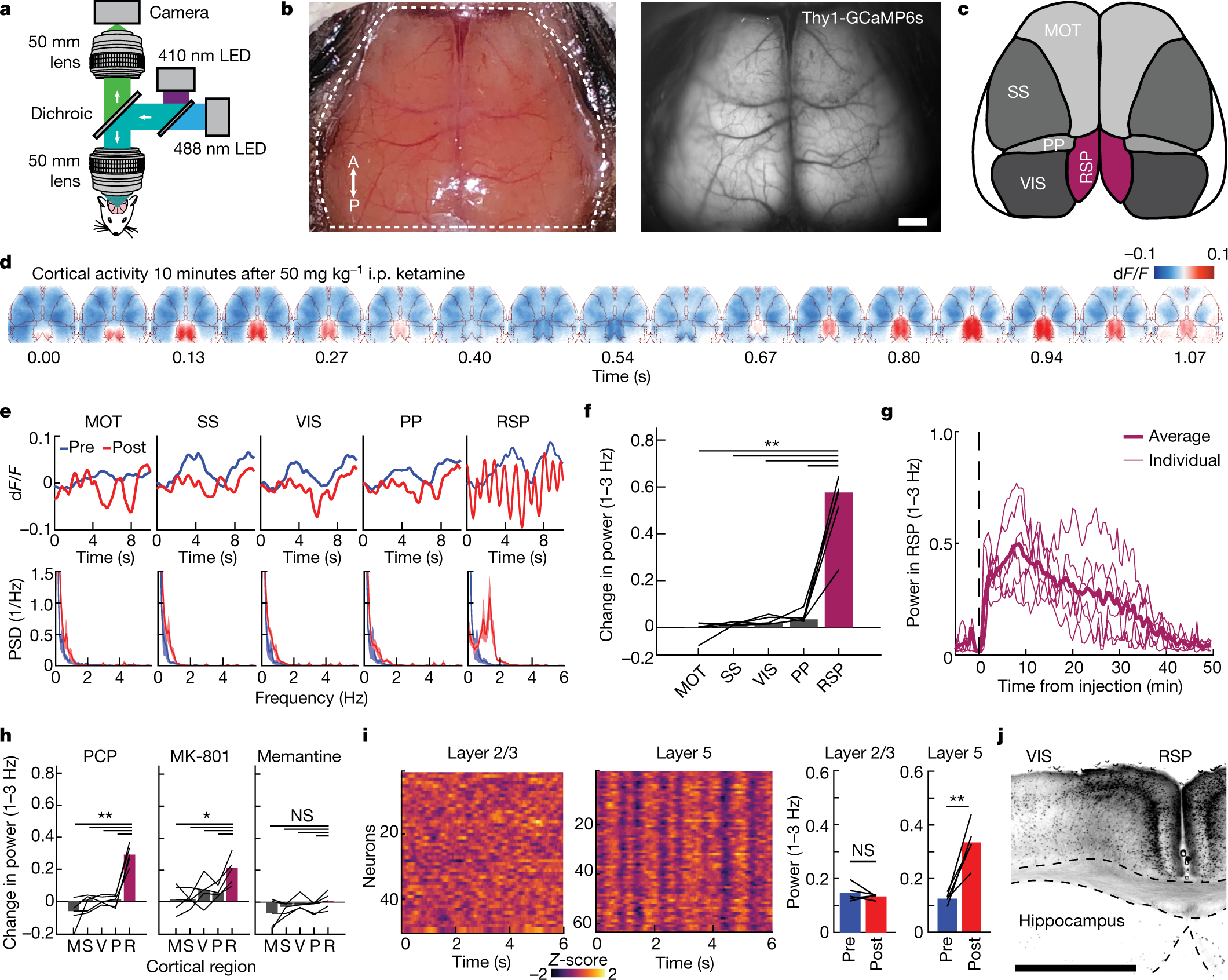
Scientists Say A Mind-Bending Rhythm In The Brain Can Act Like Ketamine (NPR, 2020)
...dissociation can be beneficial, Solt says.
For example, ketamine appears to help people with severe depression, in part because it temporarily decouples certain areas of the brain.
"There seems to be this link between dissociation and the anti-depressive effect of ketamine," he says, noting that doses too low to produce even a mildly altered state appear to offer less benefit to people with depression.

2020
The aim of this article is to argue that the ancient concept of akrasia can serve as the conceptual foundation and theoretical justification for a dual systems theory of addiction. Akrasia refers to acting against one's better judgement and thus to behaviour that agents know is bad for them and have previously resolved to abjure, addiction being seen as an extreme form of akrasia. In this way akrasia can provide the basis for accounts of addictive behaviour that stress its inconsistency over time and the great difficulty addicts experience in changing it. A definition of addiction consistent with this view is offered and defended, and some of its general advantages for understanding and responding to addiction described. A consequence of defining addiction in this way is that it should be seen as a disorder of choice or, alternatively, of self-regulation, and reasons are given why the latter term should be preferred. It is then proposed that the concept of akrasia and the perspective on addiction that follows from it lead logically to the need for a dual systems theory of addiction. Although no such theory is presented here, terminological issues are clarified, criticisms of dual systems theories are noted, and a rudimentary description of what an integrated dual systems theory of addiction might look like is provided.
Can Ketamine-Induced Near-Death Experiences Expedite Healing? (Sienknecht, 2020)
The potential for ketamine to replicate NDE’s has been supported by research. A recent study published in Science Direct, looking at over 15,000 self-reports, found that the use of ketamine, over all other psychedelic compounds, most frequently led users to have NDE’s (followed by salvia in second and peyote in third). “After assessing the semantic similarity between 15,000 reports linked to the use of 165 psychoactive substances and 625 NDE narratives, we determined that the N-methyl-D-aspartate (NMDA) receptor antagonist ketamine consistently resulted in reports most similar to those associated with NDE’s.” The authors go on to suggest that “ketamine could be used as a safe and reversible experimental model for NDE phenomenology”1

2020
Following a double-blind, placebo-controlled, parallel group design, we utilized an ultra-high field multimodal brain imaging approach and demonstrated that psilocybin (0.17 mg/kg) induced region-dependent alterations in glutamate, which predicted distortions in the subjective experience of one’s self (ego dissolution). Whereas higher levels of medial prefrontal cortical glutamate were associated with negatively experienced ego dissolution, lower levels in hippocampal glutamate were associated with positively experienced ego dissolution. Such findings provide further insights into the underlying neurobiological mechanisms of the psychedelic, as well as the baseline, state. Importantly, they may also provide a neurochemical basis for therapeutic effects as witnessed in ongoing clinical trials.

2020
This article highlights the potential spiritual effects of a popular anesthetic, ketamine, and how these spiritual effects can be used to help promote the reconciliation of spiritual and physical health. Ketamine, like the prominent psychedelic, psilocybin, has reportedly caused feelings of spiritual revelation and “out of body experiences” that many physicians may not feel qualified to discuss with their patients. This reluctance to address ketamine-induced spiritual experiences may affect the health outcomes of the patient. The primary goal of this project is to bring academic validity to considerations of the spiritual health of patients. This paper (1) investigates the extent that ketamine-induced, non-ordinary experiences can help bring awareness to the compatibility of spiritual and physical health and (2) compares the mechanisms of ketamine and psilocybin, as well as their value to the medical community due to the spiritual experiences that they catalyze. Thus, this research seeks to demonstrate that understanding the spiritual value of ketamine may encourage better communication between the physician and patient and promote more holistic healthcare approaches.

(2020) " Using source-localised, steady-state MEG recordings, we describe changes in functional connectivity following the controlled administration of LSD, psilocybin and low-dose ketamine, as well as, for comparison, the (non-psychedelic) anticonvulsant drug tiagabine. We compare both undirected and directed measures of functional connectivity between placebo and drug conditions. We observe a general decrease in directed functional connectivity for all three psychedelics, as measured by Granger causality, throughout the brain. These data support the view that the psychedelic state involves a breakdown in patterns of functional organisation or information flow in the brain"
The Tenacious Brain: How the Anterior Mid-Cingulate Contributes to Achieving Goals (Toroutoglou, 2021)
https://www.ncbi.nlm.nih.gov/pmc/articles/PMC7381101/

The anterior midcingulate cortex might be a neuronal substrate for the ideomotor mechanism (Michelet, 2021)
The way the brain controls voluntary movements for normal and pathological subject remains puzzling. In this selective review, we provide unreported harmonies between the anterior midcingulate cortex (aMCC) activities and the ideomotor mechanism postulating that voluntary movements are controlled by the anticipation of the expected perceptual consequences of an action, critically involving bidirectional interplay of a given motor activity and corresponding sensory feedback. Among other evidence, we found that the required asymmetry in the bidirectional interplay between a given motor command and its expected sensory effect could rely on the specific activity of aMCC neurons when observing errors and successes. We confirm this hypothesis by presenting a pathological perspective, studying obsessive–compulsive and other related disorders in which hyperactivated and uniform aMCC activities should lead to a circular-reflex process that results in persistent ideas and repeated actions. By evaluating normal and pathological data, we propose considering the aMCC at a central position within the cerebral network involved in the ideomotor mechanism.

Clinical studies suggest the therapeutic potential of psychedelics, including ayahuasca, DMT, psilocybin, and LSD, in stress-related disorders. These substances induce cognitive, antidepressant, anxiolytic, and antiaddictive effects suggested to arise from biological changes similar to conventional antidepressants or the rapid-acting substance ketamine. The proposed route is by inducing brain neuroplasticity. This review attempts to summarize the evidence that psychedelics induce neuroplasticity by focusing on psychedelics' cellular and molecular neuroplasticity effects after single and repeated administration. When behavioral parameters are encountered in the selected studies, the biological pathways will be linked to the behavioral effects. Additionally, knowledge gaps in the underlying biology of clinical outcomes of psychedelics are highlighted. The literature searched yielded 344 results. Title and abstract screening reduced the sample to 35; eight were included from other sources, and full-text screening resulted in the final selection of 16 preclinical and four clinical studies. Studies (n = 20) show that a single administration of a psychedelic produces rapid changes in plasticity mechanisms on a molecular, neuronal, synaptic, and dendritic level. The expression of plasticity-related genes and proteins, including Brain-Derived Neurotrophic Factor (BDNF), is changed after a single administration of psychedelics, resulting in changed neuroplasticity. The latter included more dendritic complexity, which outlasted the acute effects of the psychedelic. Repeated administration of a psychedelic directly stimulated neurogenesis and increased BDNF mRNA levels up to a month after treatment. Findings from the current review demonstrate that psychedelics induce molecular and cellular adaptations related to neuroplasticity and suggest those run parallel to the clinical effects of psychedelics, potentially underlying them. Future (pre)clinical research might focus on deciphering the specific cellular mechanism activated by different psychedelics and related to long-term clinical and biological effects to increase our understanding of the therapeutic potential of these compounds.
The anterior cingulate cortex as a key locus of ketamine’s antidepressant action (Alexander, et al, 2021)
https://www.sciencedirect.com/science/article/pii/S0149763421002049
Ketamine modulates anterior cingulate cortex (ACC) activity over minutes and hours.
•Changes in ACC activity correlate with ketamine’s antidepressant effects.
•Ketamine’s effects on anhedonia depend on modulation of dorsal and subgenual ACC.
•Ketamine’s action on ACC may reduce emotional pain and rumination.
Pivotal mental states (Brouer & Carhart-Harris, 2021)
This paper introduces a new construct, the ‘pivotal mental state’, which is defined as a hyper-plastic state aiding rapid and deep learning that can mediate psychological transformation. We believe this new construct bears relevance to a broad range of psychological and psychiatric phenomena. We argue that pivotal mental states serve an important evolutionary function, that is, to aid psychological transformation when actual or perceived environmental pressures demand this. We cite evidence that chronic stress and neurotic traits are primers for a pivotal mental state, whereas acute stress can be a trigger. Inspired by research with serotonin 2A receptor agonist psychedelics, we highlight how activity at this particular receptor can robustly and reliably induce pivotal mental states, but we argue that the capacity for pivotal mental states is an inherent property of the human brain itself. Moreover, we hypothesize that serotonergic psychedelics hijack a system that has evolved to mediate rapid and deep learning when its need is sensed. We cite a breadth of evidences linking stress via a variety of inducers, with an upregulated serotonin 2A receptor system (e.g. upregulated availability of and/or binding to the receptor) and acute stress with 5-HT release, which we argue can activate this primed system to induce a pivotal mental state. The pivotal mental state model is multi-level, linking a specific molecular gateway (increased serotonin 2A receptor signaling) with the inception of a hyper-plastic brain and mind state, enhanced rate of associative learning and the potential mediation of a psychological transformation.

(2021) Over the past decade, various N-methyl-D-aspartate modulators have failed in clinical trials, underscoring the challenges of developing novel rapid-acting antidepressants based solely on the receptor or regional targets of ketamine. Thus, identifying the effect of ketamine on the brain circuitry and networks is becoming increasingly critical. In this longitudinal functional magnetic resonance imaging study of data from 265 participants, we used a validated predictive model approach that allows the full assessment of brain functional connectivity, without the need for seed selection or connectivity summaries. First, we identified a connectome fingerprint (CFP) in healthy participants (Cohort A, n = 25) during intravenous infusion of a subanesthetic dose of ketamine, compared to normal saline. We then demonstrated the robustness and reproducibility of the discovered ketamine CFP in two separate healthy samples (Cohort B, n = 22; Cohort C, n = 18). Finally, we investigated the ketamine CFP connectivity at 1-week post treatment in major depressive disorder patients randomized to 8 weeks of sertraline or placebo (Cohort D, n = 200). We found a significant, robust, and reproducible ketamine CFP, consistent with reduced connectivity within the primary cortices and within the executive network, but increased connectivity between the executive network and the rest of the brain. Compared to placebo, the ketamine CFP connectivity changes at 1 week predicted response to sertraline at 8 weeks. In each of Cohorts A-C, ketamine significantly increased connectivity in a previously identified antidepressant CFP. Investigating the brain connectivity networks, we successfully identified a robust and reproducible ketamine biomarker that is related to the mechanisms of antidepressants.

(2022)No contemporary unifying framework has been provided for the study of non-ordinary states of consciousness (NSCs) despite increased interest in hypnosis, meditation, and psychedelics. NSCs induce shifts in experiential contents (what appears to the experiencer) and/or structure (how it appears). This can allow the investigation of the plastic and dynamic nature of experience from a multiscale perspective that includes mind, brain, body, and context. We propose a neurophenomenological (NP) approach to the study of NSCs which highlights their role as catalysts of transformation in clinical practice by refining our understanding of the relationships between experiential (subjective) and neural dynamics. We outline the ethical implications of the NP approach for standard conceptions of health and pathology as well as the crucial role of experience-based know-how in NSC-related research and application.
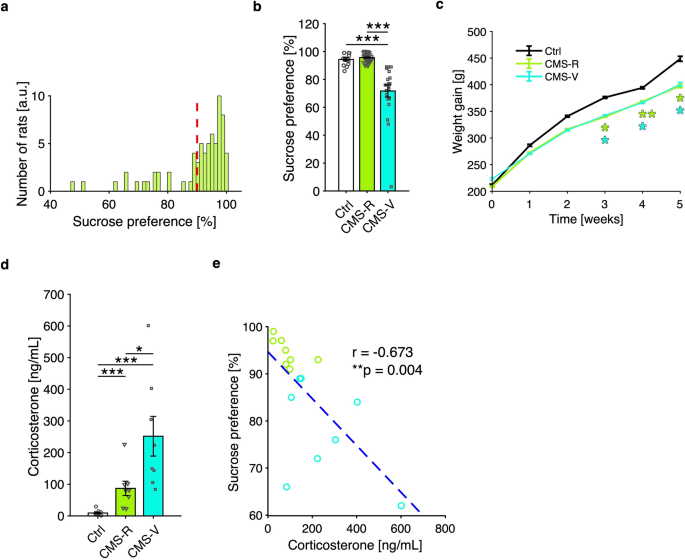
2022
...we show that the expression of DA-dependent synaptic plasticity in the medial prefrontal cortex (mPFC) is occluded in rats vulnerable to CMS, likely reflecting differential expression of AMPA receptors. Interestingly, such difference is not observed when rats are acutely treated with sub-anesthetic ketamine, possibly through the recruitment of dopaminergic nuclei such as the ventral tegmental area. In addition, by applying the synaptic activity sensor SynaptoZip in vivo, we found that chronic stress unbalances the synaptic drive from the infralimbic and prelimbic subregions of the mPFC toward the basolateral amygdala, and that this effect is counteracted by ketamine. Our results provide novel insights into the neurophysiological mechanisms behind the expression of vulnerability to stress, as well as behind the antidepressant action of ketamine.
The Philosophy of Mystical Experience (2022)

Cerebral Blood Flow and Brain Functional Connectivity Changes in Older Adults Participating in a Mindfulness-Based Stress Reduction Program (Moss, et al, 2022)

The findings are consistent with prior studies in younger populations in which the prefrontal cortex, limbic areas such as the hippocampus and the amygdala, and the posterior cingulate are affected by mindfulness programs. For example, a small study of 14 patients with mild cognitive impairment (MCI) participating in MBSR revealed increased functional connectivity between the posterior cingulate cortex and the bilateral medial prefrontal cortex and left hippocampus compared to controls [33]. These results indicated that in adults with MCI, MBSR may have a positive impact on the regions of the brain most related to MCI. In another study, 35 adults presenting with psychological distress underwent a 3-day mindfulness program and were found to have increased resting-state functional connectivity between brain regions associated with executive function [34]. Decreased resting-state functional connectivity in the amygdala–anterior cingulate cortex were also found after the 3-day mindfulness program, suggesting a pathway for the stress reduction effects of mindfulness [35]. Finally, an fMRI study by Yang et al. [36] of 13 novices with a mean age of 24 who underwent 40 days of mindfulness training showed increased connectivity between the precuneus and the temporoparietal junction, but reduced functional connectivity in the frontal brain regions. This latter finding is in the opposite direction of our findings, and future studies will be needed to determine whether these changes are distinct among differently aged patient populations.The current study supports these previous reports of neuroplastic changes with mindfulness training and adds to the growing field by observing changes in elderly adults. Our study results suggest that the MBSR program alters functional connectivity in emotional networks in older individuals. There is also overlap, with some of these regions having both altered functional connectivity as well as altered CBF. These areas include the PFC, anterior cingulate cortex, and posterior cingulate cortex, all areas involved in attentional control and emotional regulation.

(2022)The frequency of spontaneous experiences was not related to the quantity of practiced meditation or trait measures of mindfulness and affect. Self-reports included multiple descriptions of rising sensations, sometimes being directly called kundalini. Experiences with rising sensations were complex and many included references to positive affect, including ecstatic qualities. There were also reports of spontaneous anomalous experiences. These experiences of rising sensations resemble prior clinical descriptions that were considered kundalini-related. The individuals who reported rising sensations could not be distinguished from other participants based on the incidence of experiences, quantity of meditation practice, or trait measures of mindfulness and affect. In contrast, greater amount of Tantric Yoga meditation practice was associated with greater positive affect, less negative affect and greater mindfulness. Further study of these exploratory findings and how they may be related to spiritual and well-being goals of meditation is warranted along with scientific investigation of purported kundalini phenomena.
NEURAL MECHANISMS AND PSYCHOLOGY OF PSYCHEDELIC EGO DISSOLUTION (STOLIKER ET AL, 2022)
Surmising that the experience of ego dissolution exists at the center of the psychedelic experience and that its neural mechanisms may be close to the roots of the subject-object dichotomy may explain why phenomenological encounters with this experience can be intimate and fundamentally change self-identification and interactions with the world. Continued investigation of the neural mechanisms of ego dissolution and the dichotomy of separation between the self and the world may advance scientific understanding of sentience. The value of psychedelics may then, under appropriate conditions, be their power to catalyze meaningful philosophical and scientific understanding of the “u” (i.e., self) in the universe.

(2022) Results support that ketamine treatment leads to neurofunctional plasticity between distinct neural networks that are shown as disrupted in MDD patients. Cortico-striatal-cerebellar loops that encompass the SN could be a potential biomarker for ketamine treatment.
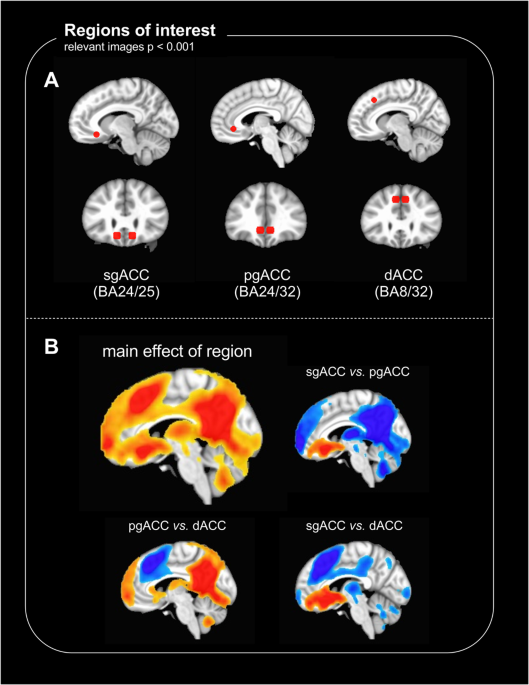
2023)
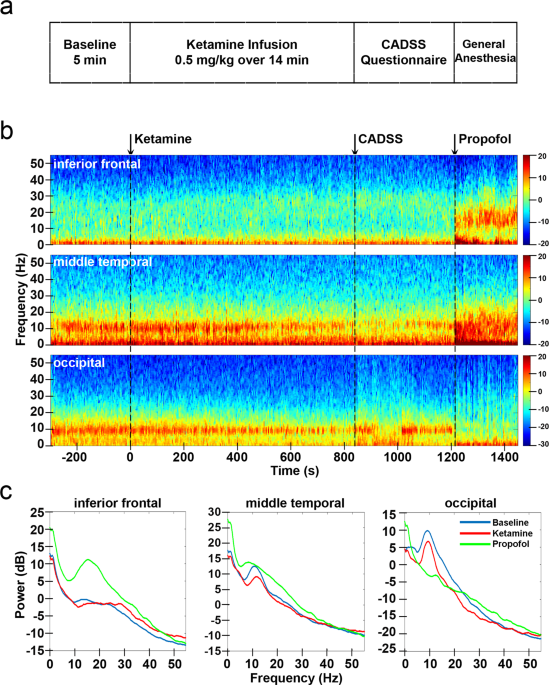
(2023)
Ketamine produces antidepressant effects in patients with treatment-resistant depression, but its usefulness is limited by its psychotropic side effects. Ketamine is thought to act via NMDA receptors and HCN1 channels to produce brain oscillations that are related to these effects. Using human intracranial recordings, we found that ketamine produces gamma oscillations in prefrontal cortex and hippocampus, structures previously implicated in ketamine’s antidepressant effects, and a 3 Hz oscillation in posteromedial cortex, previously proposed as a mechanism for its dissociative effects. We analyzed oscillatory changes after subsequent propofol administration, whose GABAergic activity antagonizes ketamine’s NMDA-mediated disinhibition, alongside a shared HCN1 inhibitory effect, to identify dynamics attributable to NMDA-mediated disinhibition versus HCN1 inhibition. Our results suggest that ketamine engages different neural circuits in distinct frequency-dependent patterns of activity to produce its antidepressant and dissociative sensory effects. These insights may help guide the development of brain dynamic biomarkers and novel therapeutics for depression.
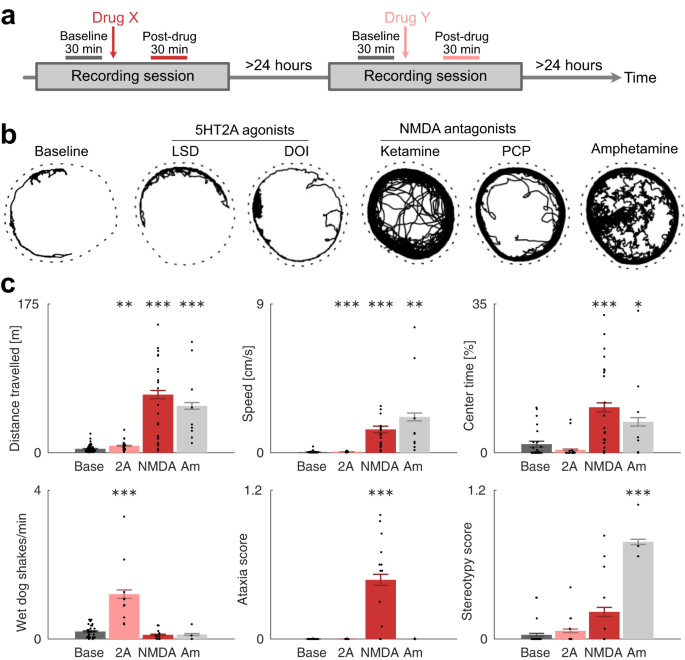
“...rats treated with 5-HT2AR psychedelics (LSD, DOI) and NMDAR psychedelics (ketamine, PCP). While interneurons and principal cells showed disparate firing rate modulations for the two classes of psychedelics, the local field potentials revealed a shared pattern of synchronized high-frequency oscillations in the ventral striatum and several cortical areas. Remarkably, the phase differences between structures were close to zero, corresponding to <1 ms delays. Likely, this hypersynchrony has major effects on the integration of information across neuronal systems and we propose that it is a key contributor to changes in perception and cognition during psychedelic drug use. Potentially, similar mechanisms could induce hallucinations and delusions in psychotic disorders and would constitute promising targets for new antipsychotic treatments.

(2023) -
Long-term meditation practice has been linked to increased cortical thickness in the brain, particularly in regions associated with attention, interoception, and sensory processing, potentially leading to enhanced memory capacity.

(2023)
Neuroimaging studies have provided evidence that extensive meditation practice modifies the functional and structural properties of the human brain, such as large-scale brain region interplay. However, it remains unclear how different meditation styles are involved in the modulation of these large-scale brain networks. Here, using machine learning and fMRI functional connectivity, we investigated how focused attention and open monitoring meditation styles impact large-scale brain networks. Specifically, we trained a classifier to predict the meditation style in two groups of subjects: expert Theravada Buddhist monks and novice meditators. We showed that the classifier was able to discriminate the meditation style only in the expert group. Additionally, by inspecting the trained classifier, we observed that the Anterior Salience and the Default Mode networks were relevant for the classification, in line with their theorized involvement in emotion and self-related regulation in meditation. Interestingly, results also highlighted the role of specific couplings between areas crucial for regulating attention and self-awareness as well as areas related to processing and integrating somatosensory information. Finally, we observed a larger involvement of left inter-hemispheric connections in the classification. In conclusion, our work supports the evidence that extensive meditation practice modulates large-scale brain networks, and that the different meditation styles differentially affect connections that subserve style-specific functions.

(2023)
Mindfulness meditation is a contemplative practice informed by Buddhism that targets the development of present-focused awareness and non-judgment of experience. Interest in mindfulness is burgeoning, and it has been shown to be effective in improving mental and physical health in clinical and non-clinical contexts. In this report, for the first time, we used electroencephalography (EEG) combined with a neurophenomenological approach to examine the neural signature of "cessation" events, which are dramatic experiences of complete discontinuation in awareness similar to the loss of consciousness, which are reported to be experienced by very experienced meditators, and are proposed to be evidence of mastery of mindfulness meditation. We intensively sampled these cessations as experienced by a single advanced meditator (with over 23,000 h of meditation training) and analyzed 37 cessation events collected in 29 EEG sessions between November 12, 2019, and March 11, 2020. Spectral analyses of the EEG data surrounding cessations showed that these events were marked by a large-scale alpha-power decrease starting around 40 s before their onset, and that this alpha-power was lowest immediately following a cessation. Region-of-interest (ROI) based examination of this finding revealed that this alpha-suppression showed a linear decrease in the occipital and parietal regions of the brain during the pre-cessation time period. Additionally, there were modest increases in theta power for the central, parietal, and right temporal ROIs during the pre-cessation timeframe, whereas power in the Delta and Beta frequency bands were not significantly different surrounding cessations. By relating cessations to objective and intrinsic measures of brain activity (i.e., EEG power) that are related to consciousness and high-level psychological functioning, these results provide evidence for the ability of experienced meditators to voluntarily modulate their state of consciousness and lay the foundation for studying these unique states using a neuroscientific approach.

2023
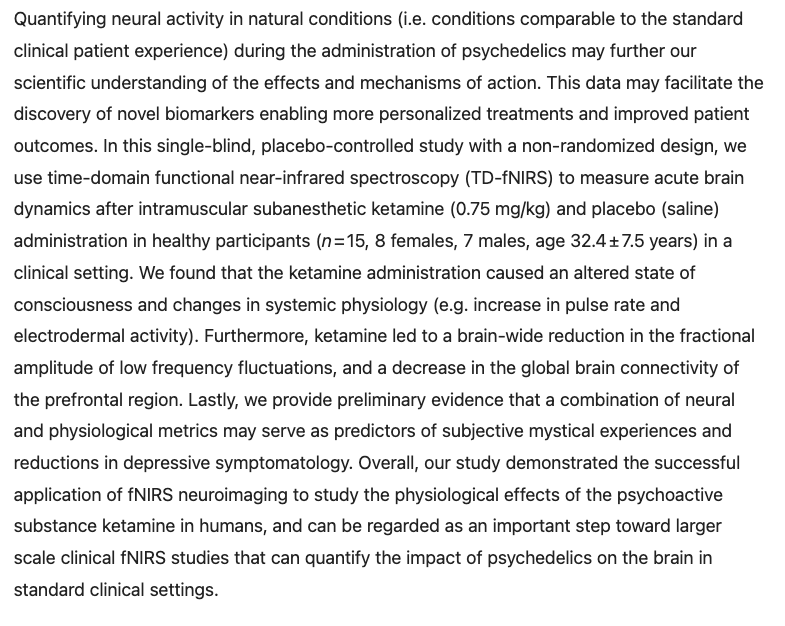

2023
Changes to sgACC-pgACC, sgACC-ventral striatal, and sgACC-dACC connectivity correlated with improvements in anhedonia symptoms.

Ketamine is an N-methyl-d-aspartate antagonist which is increasingly being researched and used as a treatment for depression. In low doses, it can cause a transitory modification in consciousness which was classically labelled as 'dissociation'. However, ketamine is also commonly classified as an atypical psychedelic and it has been recently reported that ego dissolution experiences during ketamine administration are associated with greater antidepressant response. Neuroimaging studies have highlighted several similarities between the effects of ketamine and those of serotonergic psychedelics in the brain; however, no unified account has been proposed for ketamine's multi-level effects - from molecular to network and psychological levels. Here, we propose that the fast, albeit transient, antidepressant effects observed after ketamine infusions are mainly driven by its acute modulation of reward circuits and sub-acute increase in neuroplasticity, while its dissociative and psychedelic properties are driven by dose- and context-dependent disruption of large-scale functional networks. Computationally, as nodes of the salience network (SN) represent high-level priors about the body ('minimal' self) and nodes of the default-mode network (DMN) represent the highest-level priors about narrative self-experience ('biographical' self), we propose that transitory SN desegregation and disintegration accounts for ketamine's 'dissociative' state, while transitory DMN desegregation and disintegration accounts for ketamine's 'psychedelic' state. In psychedelic-assisted psychotherapy, a relaxation of the highest-level beliefs with psychotherapeutic support may allow a revision of pathological self-representation models, for which neuroplasticity plays a permissive role. Our account provides a multi-level rationale for using the psychedelic properties of ketamine to increase its long-term benefits.
PrePrint...Not yet Peer Reviewed, but VERY exciting study, which seems in line with previous research.
Time-resolved coupling between connectome harmonics and subjective experience under the psychedelic DMT (Vohryzek, et al, 2024)

Exploring the intricate relationship between brain's structure and function, and how this affects subjective experience is a fundamental pursuit in neuroscience. Psychedelic substances offer a unique insight into the influences of specific neurotransmitter systems on perception, cognition and consciousness. Specifically, their impact on brain function propagates across the structural connectome - a network of white matter pathways linking different regions. To comprehensively grasp the effects of psychedelic compounds on brain function, we used a theoretically rigorous framework known as connectome harmonic decomposition. This framework provides a robust method to characterize how brain function intricately depends on the organized network structure of the human connectome. We show that the connectome harmonic repertoire under DMT is reshaped in line with other reported psychedelic compounds - psilocybin, LSD and ketamine. Furthermore, we show that the repertoire entropy of connectome harmonics increases under DMT, as with those other psychedelics. Importantly, we demonstrate for the first time that measures of energy spectrum difference and repertoire entropy of connectome harmonics indexes the intensity of subjective experience of the participants in a time-resolved manner reflecting close coupling between connectome harmonics and subjective experience.
(Score another one for "is ketamine a psychedelic?", by the way!)

This study included 64 adults with IGD. A total of 32 participants received MM (mean [SD] age, 20.3 [1.9] years; 17 women [53%]) and 32 received PMR (mean [SD] age, 20.2 [1.5] years; 16 women [50%]). The severity of IGD decreased in the MM group (pretest vs posttest: mean [SD], 7.0 [1.1] vs 3.6 [0.8]; P < .001) and in the PMR group (mean [SD], 7.1 [0.9] vs 6.0 [0.9]; P = .04). The MM group had a greater decrease in IGD severity than the PMR group (mean [SD] score change for the MM group vs the PMR group, -3.6 [0.3] vs -1.1 [0.2]; P < .001). Mindfulness meditation was associated with decreased brain activation in the bilateral lentiform nuclei (r = 0.40; 95% CI, 0.19 to 0.60; P = .02), insula (r = 0.35; 95% CI, 0.09 to 0.60; P = .047), and medial frontal gyrus (MFG; r = 0.43; 95% CI, 0.16 to 0.70; P = .01). Increased MFG-lentiform FC and decreased craving (pretest vs posttest: mean [SD], 58.8 [15.7] vs 33.6 [12.0]; t = -8.66; ƞ2 = 0.30; P < .001) was observed after MM, and changes in MFG-lentiform FC mediated the relationship between increased mindfulness and decreased craving (mediate effect, -0.17; 95% CI, -0.32 to -0.08; P = .03).
Conclusions and relevance: In this study, MM was more effective in decreasing addiction severity and gaming cravings compared with PMR. These findings indicate that MM may be an effective treatment for IGD and may exert its effects by altering frontopallidal pathways.
Neural correlates of mindfulness meditation and hypnosis on magnetic resonance imaging: similarities and differences. A scoping review (Sim, et al, 2024)
https://www.sciencedirect.com/science/article/abs/pii/S015098612300264X
EEG changes induced by meditative practices: State and trait effects in healthy subjects and in patients with epilepsy (Merlet, et al, 2024)
https://www.sciencedirect.com/science/article/abs/pii/S0035378724004703
The effect of meditation on brain activity has been the topic of many studies in healthy subjects and in patients suffering from chronic diseases. These effects are either explored during meditation practice (state effects) or as a longer-term result of meditation training during the resting-state (trait). The topic of this article is to first review these findings by focusing on electroencephalography (EEG) changes in healthy subjects with or without experience in meditation. Modifications in EEG baseline rhythms, functional connectivity and advanced nonlinear parameters are discussed in regard to feasibility in clinical applications. Secondly, we provide a state-of-the-art of studies that proposed meditative practices as a complementary therapy in patients with epilepsy, in whom anxiety and depressive symptoms are prevalent. In these studies, the effects of standardized meditation programs including elements of traditional meditation practices such as mindfulness, loving-kindness and compassion are explored both at the level of psychological functioning and on the occurrence of seizures. Lastly, preliminary results are given regarding our ongoing study, the aim of which is to quantify the effects of a mindfulness self-compassion (MSC) practice on interictal and ictal epileptic activity. Feasibility, difficulties, and prospects of this study are discussed.
Characterizing EEG signals of meditative states using persistent homology and Hodge spectral entropy (Gupta, et al, 2024)
https://www.sciencedirect.com/science/article/pii/S1746809423012120
We present a novel topological characterization of EEG time series signals associated with two meditative states: autobiographical self-reflection and mantra-based meditation. The results demonstrate significant information geometric differences among the two groups of meditators and the control group for two brain regions, namely anterior frontal (AF) and temporoparietal (TP). The analysis involves global topological invariants and persistent homology features of the point cloud data constructed from the EEG time series using Takens’s embedding. While traditional EEG analyses face the well-known issues of noise and artefacts, the persistent homology approach is robust to them due to its emphasis on the overall topological changes rather than the transient structures. We analyse the characteristics of the Betti areas, peak location of Betti curves, persistent entropy, persistent amplitude and Hodge spectral entropy of the meditative states for up to the second homology dimension. We find that the mantra- based meditative state is rich in persistent features compared to autobiographical self-reflection. Also, the entropic measures indicate reduced chaotic dynamics and enhanced topological structure formation for the former. Moreover, the correlation of Hodge spectral entropy with persistent entropy or Betti area in a group is a key feature in differentiating the TP and AF channels. These topological features can be used to classify the meditative states with more than 95% accuracy.

(2024)
Self-transcendence – characterized by ego dissolution, affective bliss, and a merging or softening of boundary between self and other/object (i.e., non-duality) – is a phenomenological experience reported across multiple contemplative, philosophical, religious and spiritual traditions around the world for thousands of years. This experience is valued as a catalyst for compassionate behavior and self-actualization. Considerable evidence indicates that psychedelics can induce radical experiences of self-transcendence. We argue that self-transcendence, and what have been called altered states of consciousness or peak experiences, should be a legitimate area of study. We believe that it is now warranted to rigorously interrogate these phenomena in the context of modern psychiatry, and that this pursuit may provide new avenues to foster psychological thriving in clinical and non-clinical contexts.
World Psychiatry Association - https://onlinelibrary.wiley.com/doi/10.1002/wps.21214

Meditation’s potential has been demonstrated by numerous contemplative, philosophical, religious and spiritual traditions that teach it as a core element that leads to enlightenment or salvation. Buddhism, Vedic and Hindu practices, Jewish kabbalism, Islamic Sufism and shamanism, among others, have all explored meditation in their traditions. Some of them have multimillennia-long histories and encompass experiences that include states of ecstasy, insights into the nature of the self and the world around us, the cultivation of empathy, and the pursuit of altruistic goals. Such experiences have also been reported to sometimes lead to a sense of transcendence.
The experiences and personal transformations that practitioners describe are thought to undergird entirely new psychological perspectives and ways of existing in the world. Advanced meditation may help inspire people and provide deep insight and clarity about how to achieve meaning in life. It is not uncommon, in fact, for individuals to reassess their careers or life goals after a meditation retreat and go on to pursue a path that is more fulfilling and that is more aligned with their deeper values and perspectives.


Understanding advanced mindfulness practice has important implications for mental health and general wellbeing. According to Theravada Buddhist meditation, a "cessation" event is a dramatic experience of profound clarity and equanimity that involves a complete discontinuation in experience, and is evidence of mastery of mindfulness meditation. Thirty-seven cessation events were captured in a single intensively sampled advanced meditator (over 6,000 h of retreat mindfulness meditation training) while recording electroencephalography (EEG) in 29 sessions between November 12, 2019 and March 11, 2020. Functional connectivity and network integration were assessed from 40 s prior to cessations to 40 s after cessations. From 21 s prior to cessations there was a linear decrease in large-scale functional interactions at the whole-brain level in the alpha band. In the 40 s following cessations these interactions linearly returned to prior levels. No modulation of network integration was observed. The decrease in whole-brain functional connectivity was underlain by frontal to left temporal and to more posterior decreases in connectivity, while the increase was underlain by wide-spread increases in connectivity. These results provide neuroscientific evidence of large-scale modulation of brain activity related to cessation events that provides a foundation for future studies of advanced meditation.
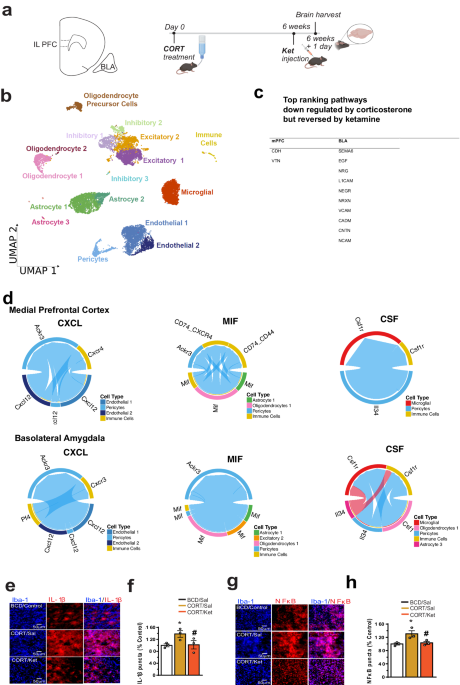
Single administration of low-dose ketamine has both acute and sustained anti-depressant effects. Sustained effect is associated with restoration of glutamatergic synapses in medial prefrontal cortic (mFPC) neurons.
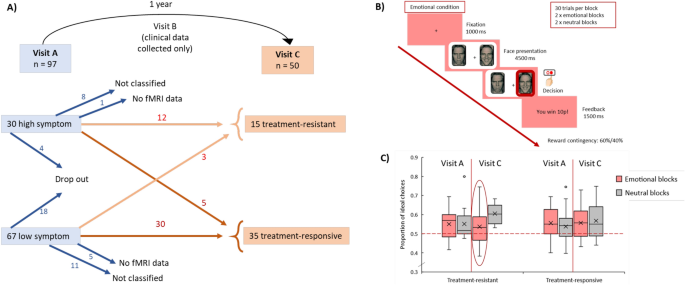
Similar to the current findings, this suggests improvement in prefrontal cortex function is important for treatment response. Interestingly, the same authors reported that greater functional connectivity between ACC and putamen at baseline predicted subsequent better treatment response9

Kim, et al, 2024:
These data further substantiate the postsynaptic action of ketamine and show it can offset impaired synaptic activity resulting from presynaptic mechanisms although it does not correct the actual synaptic deficits. Indeed, the rapid antidepressant action of ketamine in treatment resistant depression patients, which may have been afflicted by the disorder for years, suggests functional synaptic changes may be a critical component of the response rather than ‘fixing’ years of pathology in a time frame of a few hours. Therefore, patients initially responding to ketamine treatment may still possess the synaptic deficits that underlie depression. These findings highlight key principles underlying rapid antidepressant action as well as pinpoint critical differences between the mechanisms that underlie depression versus antidepressant action.
Notes: This last one is hugely important in that it suggests ketamine can compensate for synaptic deficits that may lead to depression, but the underlying deficits are still there- ie, you’re able to fall back into those cognitive behavioral patterns that lead to depression. The deficits are parts of your brain that are connecting in ways that are leading to thoughts, feelings, and behaviors that are ultimately unhealthy, and present in ways psychiatrists have named “depression”, “schizophrenia”, “PTSD”, etc. These diagnoses have been studied in combination with a mind-body approach such as cognitive behavioral therapy, as a primary treatment approach, as well as in combination with pharmacotherapy.
Ketamine may be a rapid antidepressant for some, and there is a wealth of supporting data that suggests cognitive-behavioral therapy which include mind-body practices like meditation maintain the types of improvements seen in ketamine treatment at sub-anesthetic doses, though not anesthetic doses.
The experience of psychedelic ego loss, include the subjective experiences of ketamine seem to be described similarly to advanced-level meditation, and it does seem that similar areas of the brain are identified.

...using frequency power spectrum analyses, we observed that relative to placebo, THC was associated with widespread reduced spectral power within the prefrontal cortex across the 0.073–0.1 Hz frequency range at p < 0.039. These neural features suggest a disruptive influence of THC on the neural dynamics of the prefrontal cortex and may underlie cognitive impairing effects of THC that are detectable with portable imaging.

Ketamine is an N-methyl-D-aspartate (NMDA)-receptor antagonist that produces sedation, analgesia, and dissociation at low doses and profound unconsciousness with antinociception at high doses. At high and low doses, ketamine can generate gamma oscillations (>25 Hz) in the electroencephalogram (EEG). The gamma oscillations are interrupted by slow-delta oscillations (0.1 to 4 Hz) at high doses. Ketamine’s primary molecular targets and its oscillatory dynamics have been characterized. However, how the actions of ketamine at the subcellular level give rise to the oscillatory dynamics observed at the network level remains unknown. By developing a biophysical model of cortical circuits, we demonstrate how NMDA-receptor antagonism by ketamine can produce the oscillatory dynamics observed in human EEG recordings and nonhuman primate local field potential recordings. We have identified how impaired NMDA-receptor kinetics can cause disinhibition in neuronal circuits and how a disinhibited interaction between NMDA-receptor-mediated excitation and GABA-receptor-mediated inhibition can produce gamma oscillations at high and low doses, and slow-delta oscillations at high doses. Our work uncovers general mechanisms for generating oscillatory brain dynamics that differs from ones previously reported and provides important insights into ketamine’s mechanisms of action as an anesthetic and as a therapy for treatment-resistant depression.

The model makes another prediction that might help explain how ketamine exerts its antidepressant effects. It suggests that the increased gamma activity of ketamine could entrain gamma activity among neurons expressing a peptide called VIP. This peptide has been found to have health-promoting effects, such as reducing inflammation, that last much longer than ketamine’s effects on NMDA receptors. The research team proposes that the entrainment of these neurons under ketamine could increase the release of the beneficial peptide, as observed when these cells are stimulated in experiments. This also hints at therapeutic features of ketamine that may go beyond antidepressant effects. The research team acknowledges, however, that this connection is speculative and awaits specific experimental validation.
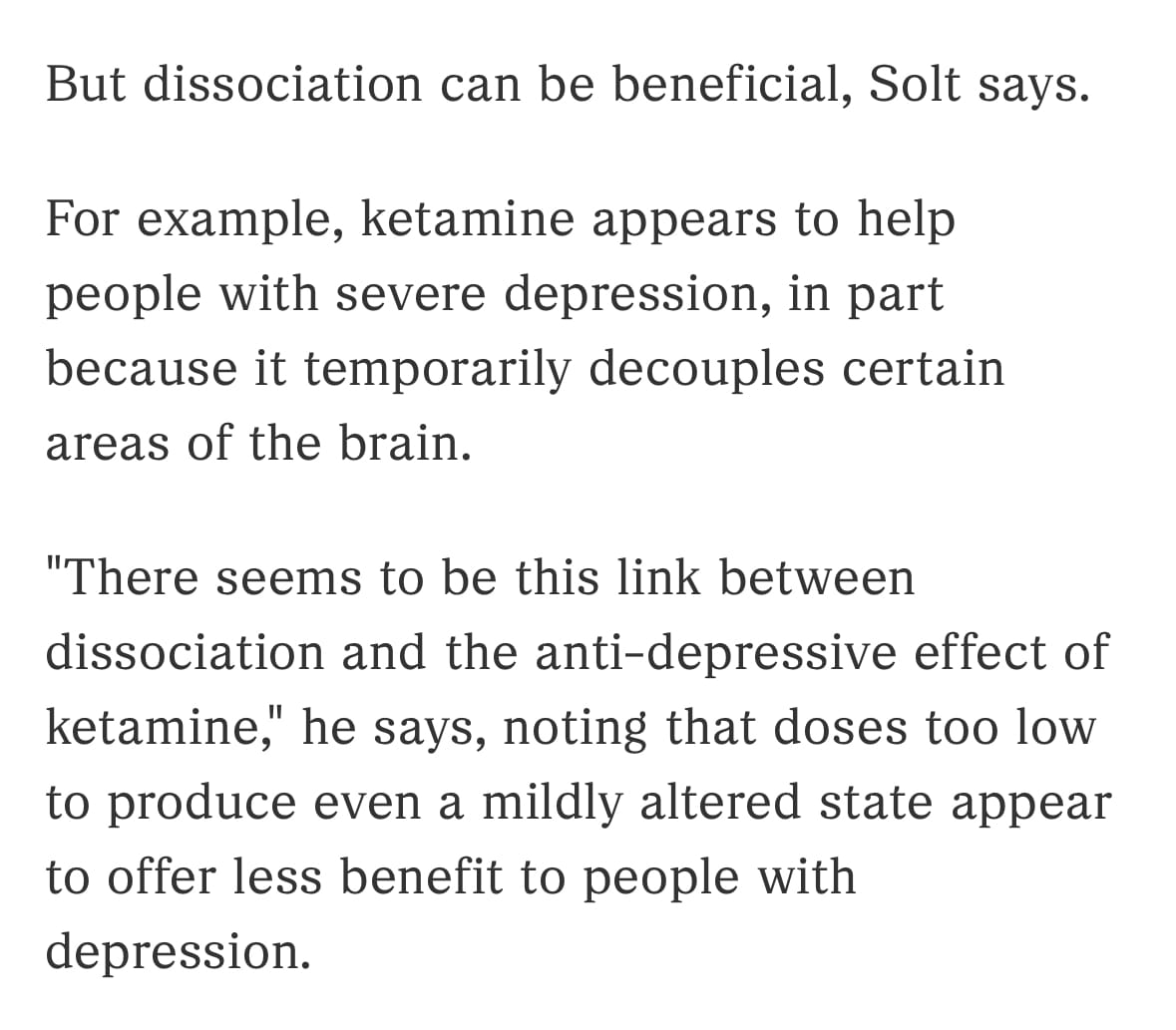

July, 2024
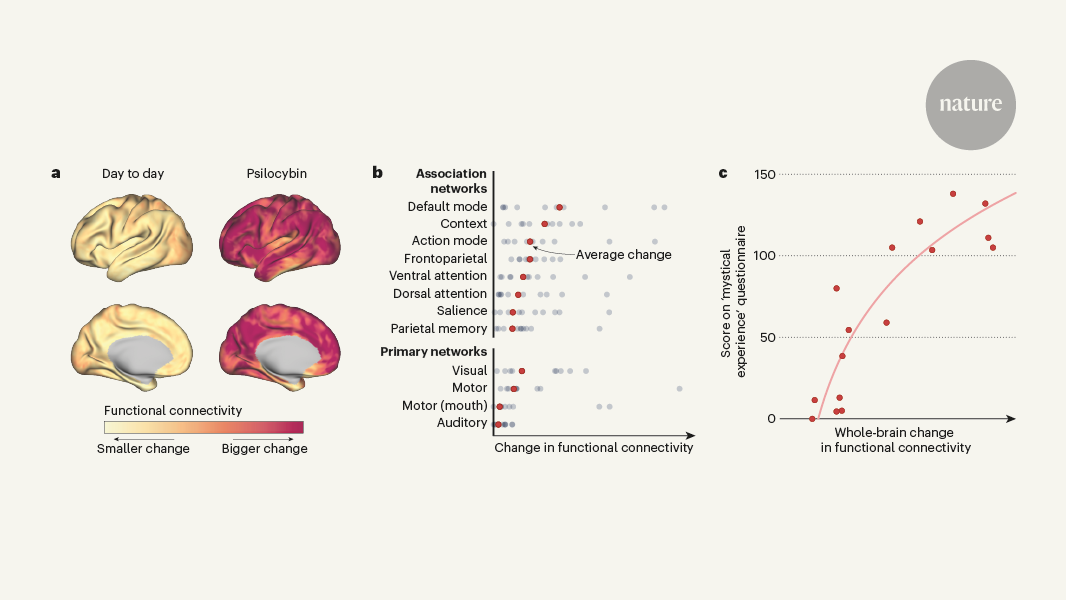
(2024)
Results from modern clinical trials over the past two decades suggest that psilocybin, coupled with talk therapy, can be used to treat major depressive disorder1,2, addiction3, existential distress4,5 and more. Interestingly, the therapeutic effects of psilocybin are not only rapid but also sustained, often lasting weeks, months or even years6,7. However, the brain states underlying the acute and persistent effects of psilocybin remain mostly unknown. Writing in Nature, Siegel et al.8 report their analyses of brain changes in healthy volunteers who ingested a high dose of psilocybin, providing remarkable insights into the mechanisms by which psilocybin alters brain function both acutely and persistently.

(Pre-print 2024): We show that the connectome harmonic repertoire under DMT is reshaped in line with other reported psychedelic compounds - psilocybin, LSD and ketamine. Furthermore, we show that the repertoire entropy of connectome harmonics increases under DMT, as with those other psychedelics. Importantly, we demonstrate for the first time that measures of energy spectrum difference and repertoire entropy of connectome harmonics indexes the intensity of subjective experience of the participants in a time-resolved manner reflecting close coupling between connectome harmonics and subjective experience.
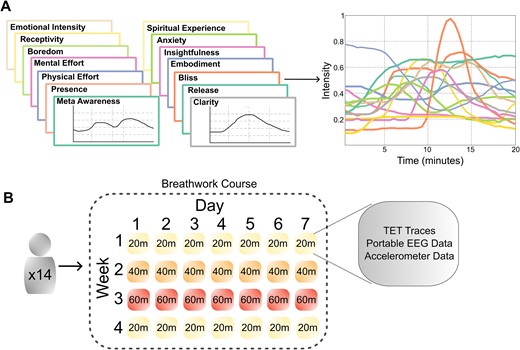
2024

The serotonin deficit hypothesis explanation for major depressive disorder (MDD) has persisted among clinicians and the general public alike despite insufficient supporting evidence.
See How the Brain Responds to Psychedelic ‘Magic Mushrooms’
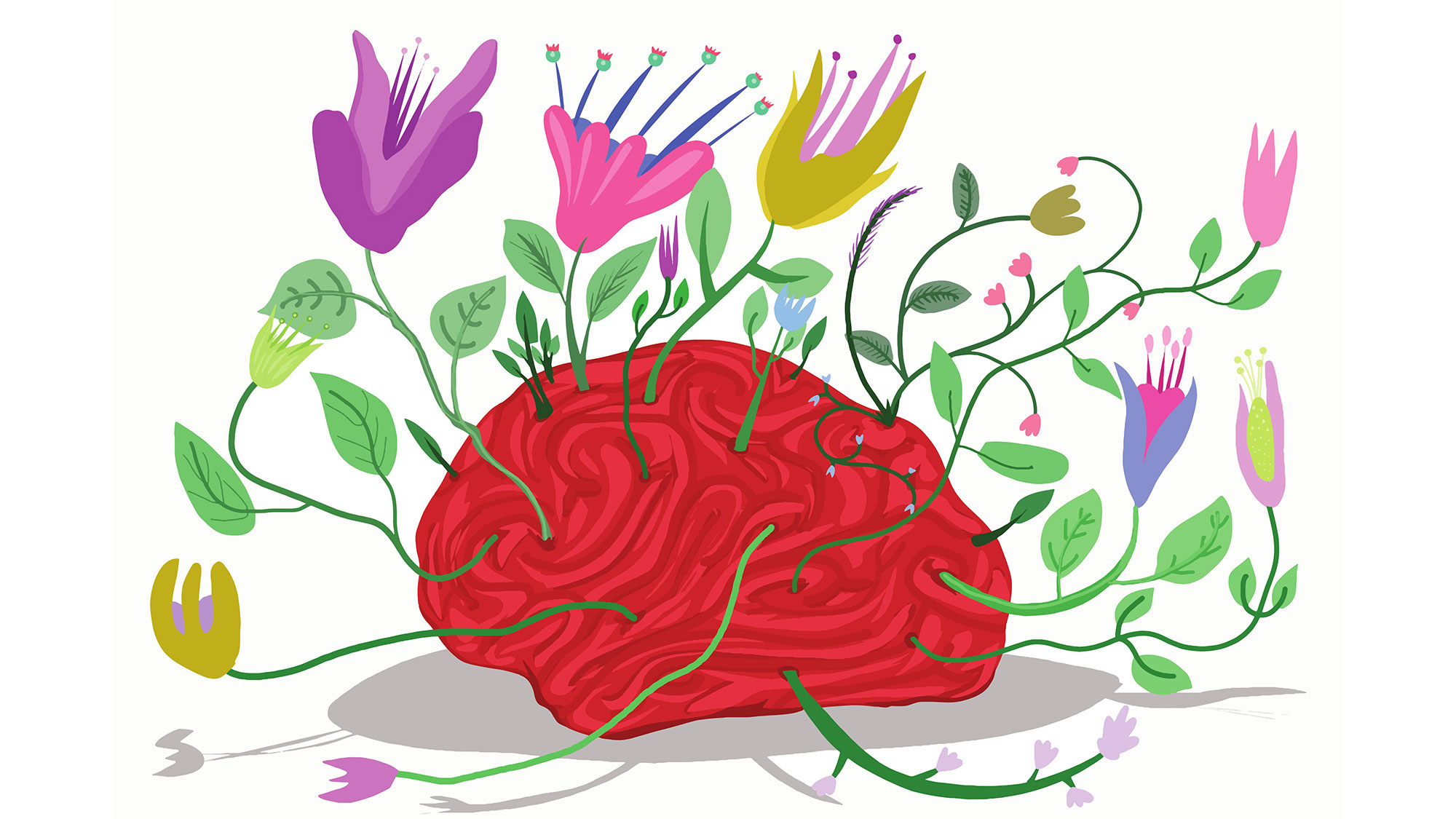
Exploring the transformative potential of out-of-body experiences: A pathway to enhanced empathy (Weiler, et al, 2024) :
...embodiment, body ownership, self-location, and first-person perspective serve as fundamental pillars of bodily self-consciousness (Gallagher, 2000, Seghezzi et al., 2019). A substantial body of evidence has correlated the sensation of embodiment (Arzy et al., 2006), self-location, and first-person perspective (Ionta et al., 2011, Ionta et al., 2014), as well as body ownership (Limanowski and Blankenburg, 2016) with a specific brain region known as the temporoparietal junction.
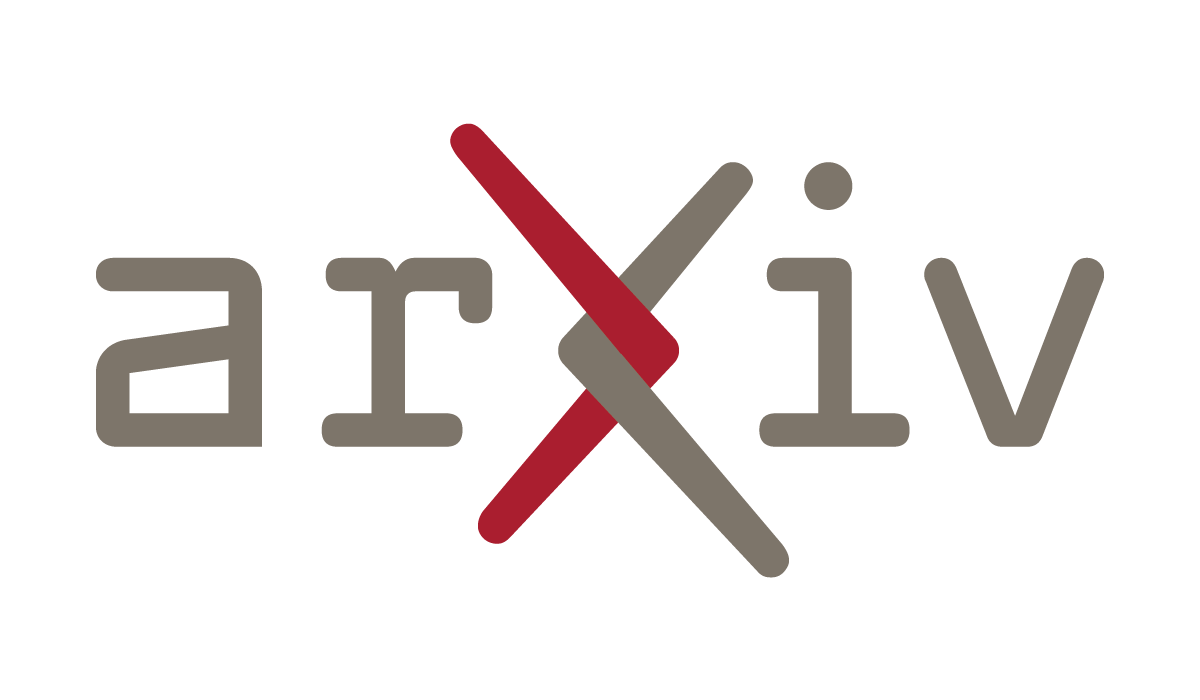
(2024)
Related Lit Review Analysis: Does the Psychedelic Experience Matter?
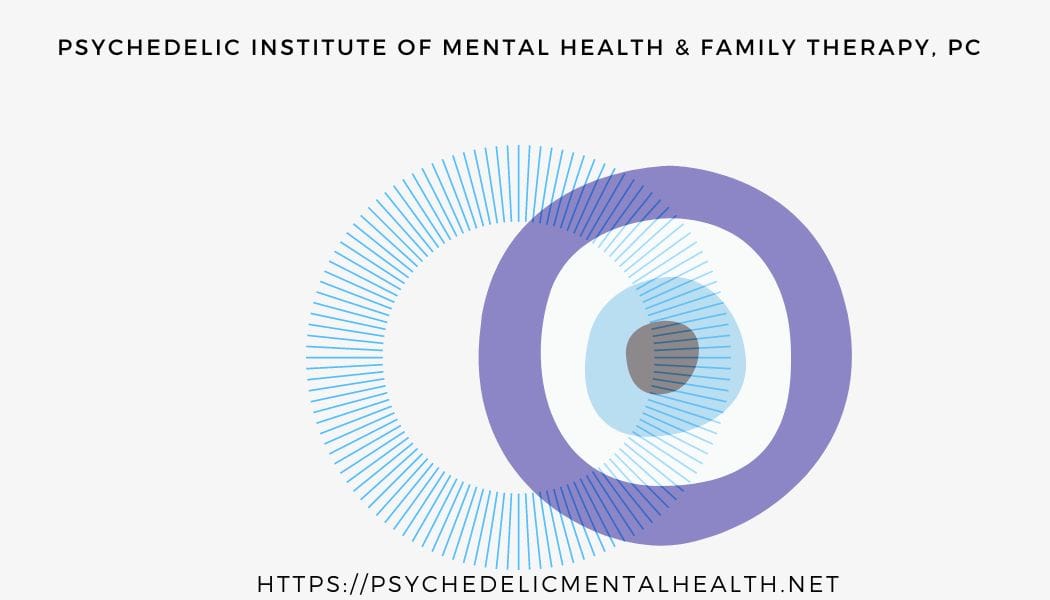

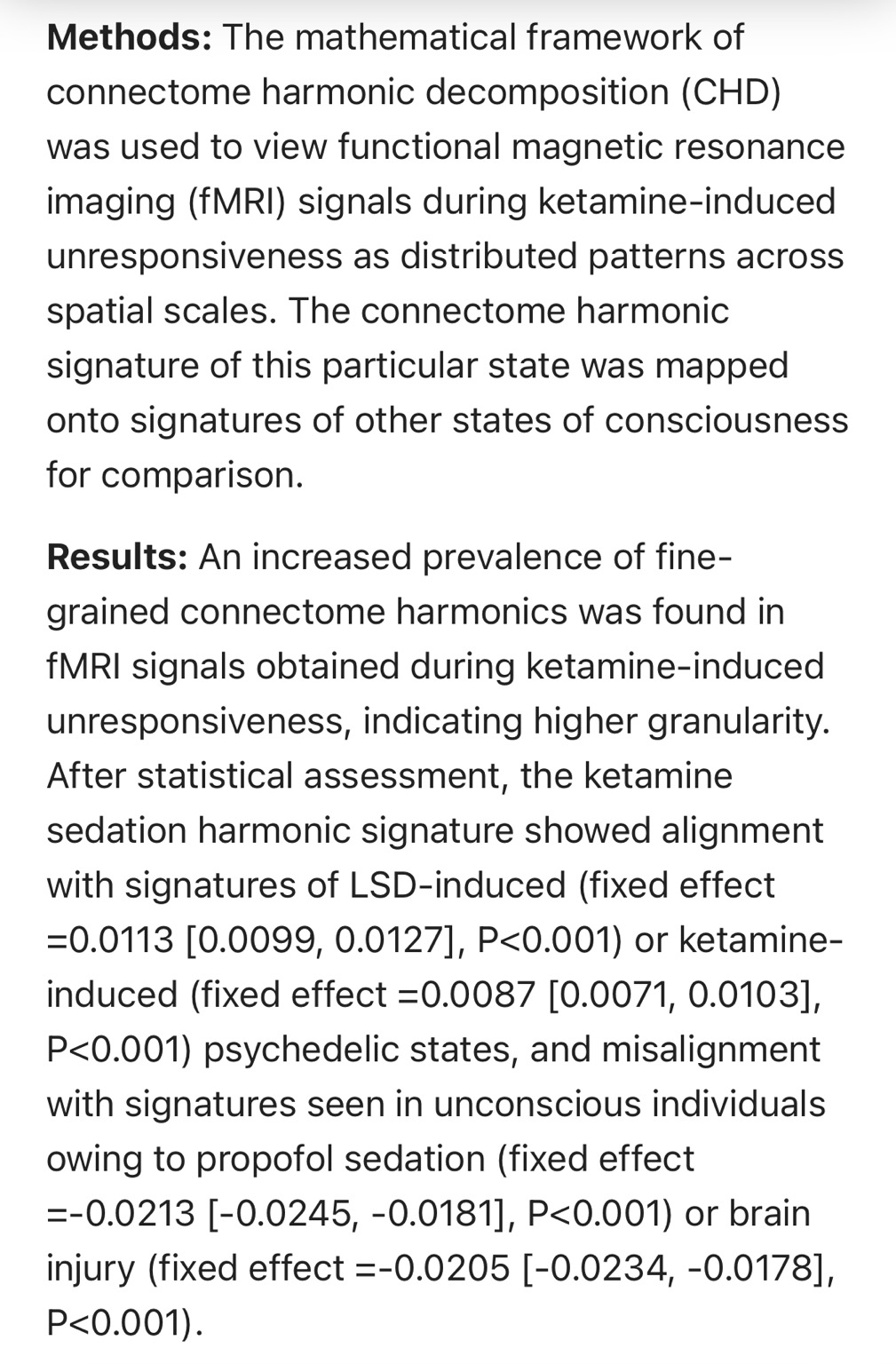

Bibliography / Bibliografía
1952
- Lindsley, D. B. (1952). Psychological phenomena and the electroencephalogram. Electroencephalography and Clinical Neurophysiology, 4(3), 443-456. DOI: 10.1016/0013-4694(52)90075-8
Traducción: Lindsley, D. B. (1952). Fenómenos psicológicos y el electroencefalograma. Electroencefalografía y Neurofisiología Clínica, 4(3), 443-456.
1974
- Hirai, T. (1974). EEG changes in Zen meditation. Psychologia, 17(3), 132-143.
Traducción: Hirai, T. (1974). Cambios en el EEG durante la meditación Zen. Psychologia, 17(3), 132-143.
2004
- McFarlane, A. C. (2004). EEG correlates of stages of meditative quiescence: A pilot study. Neuropsychobiology, 50(1), 79-86.
Traducción: McFarlane, A. C. (2004). Correlatos de EEG de las etapas de quietud meditativa: Un estudio piloto. Neuropsicobiología, 50(1), 79-86.
2008
- Davidson, R. J. (2008). Buddha’s Brain: Neuroplasticity and Meditation. Wiley. DOI: 10.1002/9781119171690
Traducción: Davidson, R. J. (2008). El cerebro de Buda: Neuroplasticidad y meditación. Wiley. - Cavanna, A. E., & Trimble, M. R. (2008). The precuneus: A review of its functional anatomy and behavioural correlates. Brain, 129(3), 564-583.
Traducción: Cavanna, A. E., & Trimble, M. R. (2008). El precuneus: Una revisión de su anatomía funcional y correlatos conductuales. Cerebro, 129(3), 564-583.
2012
- Denny, B. T., Kober, H., Wager, T. D., & Ochsner, K. N. (2012). A meta-analysis of functional neuroimaging studies of self and other judgments reveals a spatial gradient for mentalizing in medial prefrontal cortex. Journal of Cognitive Neuroscience, 24(8), 1742-1752. DOI: 10.1162/jocn_a_00233
Traducción: Denny, B. T., Kober, H., Wager, T. D., & Ochsner, K. N. (2012). Un metanálisis de estudios de neuroimagen funcional sobre juicios sobre uno mismo y los demás revela un gradiente espacial para la mentalización en la corteza prefrontal medial. Revista de Neurociencia Cognitiva, 24(8), 1742-1752.
2013
- Schartner, M., Carhart-Harris, R. L., Barrett, A. B., Seth, A. K., & Muthukumaraswamy, S. D. (2013). Increased spontaneous MEG signal diversity for psychoactive doses of ketamine, LSD, and psilocybin. Scientific Reports, 3(46421). DOI: 10.1038/srep46421
Traducción: Schartner, M., Carhart-Harris, R. L., Barrett, A. B., Seth, A. K., & Muthukumaraswamy, S. D. (2013). Mayor diversidad espontánea de señales MEG para dosis psicoactivas de ketamina, LSD y psilocibina. Informes Científicos, 3(46421).
2014
- Newberg, A. B. (2014). The neuroscientific study of spiritual practices. Frontiers in Psychology, 5, 215. DOI: 10.3389/fpsyg.2014.00215
Traducción: Newberg, A. B. (2014). El estudio neurocientífico de las prácticas espirituales. Fronteras en Psicología, 5, 215. - Kolp, E., Friedman, H., Young, M. S., Krupitsky, E., & Jansen, K. (2014). Ketamine psychedelic psychotherapy: Focus on its pharmacology, phenomenology, and clinical applications. International Journal of Transpersonal Studies, 33(2), 93-105. Link
Traducción: Kolp, E., Friedman, H., Young, M. S., Krupitsky, E., & Jansen, K. (2014). Psicoterapia psicodélica con ketamina: Enfoque en su farmacología, fenomenología y aplicaciones clínicas. Revista Internacional de Estudios Transpersonales, 33(2), 93-105.
2015
- Fox, K. C. R., Nijeboer, S., Solomonova, E., Domhoff, G. W., & Christoff, K. (2015). The meditative mind: A comprehensive meta-analysis of MRI studies. Neuroscience & Biobehavioral Reviews, 57, 401-411. DOI: 10.1016/j.neubiorev.2015.08.013
Traducción: Fox, K. C. R., Nijeboer, S., Solomonova, E., Domhoff, G. W., & Christoff, K. (2015). La mente meditativa: Un metaanálisis exhaustivo de estudios de resonancia magnética. Neurociencia y Revisiones Bioconductuales, 57, 401-411. - Sampedro, F., Ramos, R., Valle, M., Medina, G., & de la Fuente, L. (2015). The psychedelic state induced by ayahuasca modulates the activity and connectivity of the default mode network. Frontiers in Neuroscience, 9, 661. DOI: 10.3389/fnins.2015.00661
Traducción: Sampedro, F., Ramos, R., Valle, M., Medina, G., & de la Fuente, L. (2015). El estado psicodélico inducido por la ayahuasca modula la actividad y conectividad de la red de modo predeterminado. Fronteras en Neurociencia, 9, 661. - Kaur, S., & Singh, A. (2015). EEG derived neuronal dynamics during meditation: Progress and challenges. Frontiers in Psychology, 6, 768. DOI: 10.3389/fpsyg.2015.00768
Traducción: Kaur, S., & Singh, A. (2015). Dinámicas neuronales derivadas del EEG durante la meditación: Avances y desafíos. Fronteras en Psicología, 6, 768.
2016
- Acevedo, B. P., Pospos, S., & Lavretsky, H. (2016). The neural mechanisms of meditative practices: Novel approaches for healthy aging. Aging and Disease, 7(6), 327-339. DOI: 10.14336/AD.2016.0302
Traducción: Acevedo, B. P., Pospos, S., & Lavretsky, H. (2016). Los mecanismos neuronales de las prácticas meditativas: Nuevas estrategias para un envejecimiento saludable. Envejecimiento y Enfermedad, 7(6), 327-339. - Simpkins, C., & Simpkins, A. (2016). Core Principles of Meditation for Therapy: Improving the Outcomes of Psychotherapeutic Treatments. Wiley. DOI: 10.1002/9781119171690
Traducción: Simpkins, C., & Simpkins, A. (2016). Principios fundamentales de la meditación para la terapia: Mejorando los resultados de los tratamientos psicoterapéuticos. Wiley.
2017
- Fox, K. C. R., Nijeboer, S., Solomonova, E., Domhoff, G. W., & Christoff, K. (2017). Dreams and psychedelics: Neurophenomenological comparison and therapeutic implications. Frontiers in Psychology, 8, 17. DOI: 10.3389/fpsyg.2017.00017
Traducción: Fox, K. C. R., Nijeboer, S., Solomonova, E., Domhoff, G. W., & Christoff, K. (2017). Sueños y psicodélicos: Comparación neurofenomenológica e implicaciones terapéuticas. Fronteras en Psicología, 8, 17. - Schartner, M., Carhart-Harris, R. L., Barrett, A. B., Seth, A. K., & Muthukumaraswamy, S. D. (2017). Increased spontaneous MEG signal diversity for psychoactive doses of ketamine, LSD, and psilocybin. Scientific Reports, 7(46421). DOI: 10.1038/srep46421
Traducción: Schartner, M., Carhart-Harris, R. L., Barrett, A. B., Seth, A. K., & Muthukumaraswamy, S. D. (2017). Mayor diversidad espontánea de señales MEG para dosis psicoactivas de ketamina, LSD y psilocibina. Informes Científicos, 7(46421). - Sudheimer, K. D., Keller, J., Gomez, R., Tennakoon, L., Reiss, A., & Schatzberg, A. F. (2017). Cognitive behavioral therapy changes functional connectivity between medial prefrontal and anterior cingulate cortices. Psychiatry Research: Neuroimaging, 262, 15-23. DOI: 10.1016/j.pscychresns.2017.02.004
Traducción: Sudheimer, K. D., Keller, J., Gomez, R., Tennakoon, L., Reiss, A., & Schatzberg, A. F. (2017). La terapia cognitivo-conductual cambia la conectividad funcional entre las cortezas prefrontal medial y cingulada anterior. Investigación en Psiquiatría: Neuroimagen, 262, 15-23.
2018
- Ionescu, D. F., Papakostas, G. I., & Vahabzadeh, A. (2018). Ketamine-associated brain changes: A review of the neuroimaging literature. Frontiers in Psychiatry, 9, 81. DOI: 10.3389/fpsyt.2018.00081
Traducción: Ionescu, D. F., Papakostas, G. I., & Vahabzadeh, A. (2018). Cambios cerebrales asociados a la ketamina: Una revisión de la literatura sobre neuroimagen. Fronteras en Psiquiatría, 9, 81. - Schoenfeld, T. J., Rada, P., Pieruzzini, P. R., Hsueh, B., & Gould, E. (2018). Ketamine and pharmacological imaging: Use of functional magnetic resonance imaging to evaluate mechanisms of action. Neuropsychopharmacology, 43(6), 1192-1199. DOI: 10.1038/npp.2017.306
Traducción: Schoenfeld, T. J., Rada, P., Pieruzzini, P. R., Hsueh, B., & Gould, E. (2018). Ketamina e imagen farmacológica: Uso de resonancia magnética funcional para evaluar mecanismos de acción. Neuropsicofarmacología, 43(6), 1192-1199. - Berkovich-Ohana, A., Dor-Ziderman, Y., & Goldstein, A. (2018). Mapping complex mind states: EEG neural substrates of meditative unified compassionate awareness. Neuroscience, 371, 68-78. DOI: 10.1016/j.neuroscience.2017.11.023
Traducción: Berkovich-Ohana, A., Dor-Ziderman, Y., & Goldstein, A. (2018). Mapeo de estados mentales complejos: Sustratos neuronales EEG de la conciencia compasiva unificada meditativa. Neurociencia, 371, 68-78.
2019
- Murakami, H., Nakahachi, T., Nishimura, T., & Sakamoto, K. (2019). Impact of short- and long-term mindfulness meditation training on amygdala reactivity to emotional stimuli. Frontiers in Psychology, 10, 67. DOI: 10.3389/fpsyg.2019.00067
Traducción: Murakami, H., Nakahachi, T., Nishimura, T., & Sakamoto, K. (2019). Impacto del entrenamiento de meditación mindfulness a corto y largo plazo en la reactividad de la amígdala a estímulos emocionales. Fronteras en Psicología, 10, 67.
2020
- Palhano-Fontes, F., Andrade, K. C., Tofoli, L. F., & Ribeiro, S. (2020). The psychedelic state induced by ayahuasca modulates the activity and connectivity of the default mode network. NeuroImage, 220, 117083. DOI: 10.1016/j.neuroimage.2020.117083
Traducción: Palhano-Fontes, F., Andrade, K. C., Tofoli, L. F., & Ribeiro, S. (2020). El estado psicodélico inducido por la ayahuasca modula la actividad y conectividad de la red de modo predeterminado. NeuroImagen, 220, 117083.
2021
- Carhart-Harris, R. L., & Friston, K. J. (2021). REBUS and the anarchic brain: Toward a unified model of the brain action of psychedelics. Pharmacological Reviews, 73(3), 264-320. DOI: 10.1124/pharmrev.120.000042
Traducción: Carhart-Harris, R. L., & Friston, K. J. (2021). REBUS y el cerebro anárquico: Hacia un modelo unificado de la acción cerebral de los psicodélicos. Revisiones Farmacológicas, 73(3), 264-320. - Griffiths, R. R., Johnson, M. W., & Richards, W. A. (2021). Psilocybin-occasioned mystical-type experiences: Immediate and persisting dose-related effects. Journal of Psychopharmacology, 35(8), 875-890. DOI: 10.1177/02698811211036288
Traducción: Griffiths, R. R., Johnson, M. W., & Richards, W. A. (2021). Experiencias místicas inducidas por psilocibina: Efectos inmediatos y persistentes relacionados con la dosis. Revista de Psicofarmacología, 35(8), 875-890.
2022
- Yaden, D. B., & Newberg, A. B. (2022). The neuroscience of psychedelics: Implications for understanding altered states of consciousness. Trends in Cognitive Sciences, 26(4), 289-303. DOI: 10.1016/j.tics.2022.01.007
Traducción: Yaden, D. B., & Newberg, A. B. (2022). La neurociencia de los psicodélicos: Implicaciones para la comprensión de los estados alterados de conciencia. Tendencias en Ciencias Cognitivas, 26(4), 289-303. - Barrett, F. S., Preller, K. H., & Kaelen, M. (2022). Psychedelic therapy: Effects on brain network dynamics and therapeutic mechanisms. Neuropsychopharmacology, 47(6), 1181-1197. DOI: 10.1038/s41386-022-01257-w
Traducción: Barrett, F. S., Preller, K. H., & Kaelen, M. (2022). Terapia psicodélica: Efectos sobre la dinámica de la red cerebral y mecanismos terapéuticos. Neuropsicofarmacología, 47(6), 1181-1197.
2023
- McCulloch, D. E.-W., Friston, K. J., & Carhart-Harris, R. L. (2023). Psychedelic-induced neuroplasticity and the prediction error minimization framework. Nature Communications, 14, 3291. DOI: 10.1038/s41467-023-38184-6
Traducción: McCulloch, D. E.-W., Friston, K. J., & Carhart-Harris, R. L. (2023). Neuroplasticidad inducida por psicodélicos y el marco de minimización del error de predicción. Comunicaciones de la Naturaleza, 14, 3291. - Petri, G., Expert, P., & Turkheimer, F. (2023). The topology of psychedelic states: A new framework for understanding altered consciousness. Cerebral Cortex, 33(5), 2334-2350. DOI: 10.1093/cercor/bhac283
Traducción: Petri, G., Expert, P., & Turkheimer, F. (2023). La topología de los estados psicodélicos: Un nuevo marco para comprender la conciencia alterada. Corteza Cerebral, 33(5), 2334-2350.
2024
- Vollenweider, F. X., & Kometer, M. (2024). Serotonergic hallucinogens in psychiatry: Therapeutic potential and neurobiological mechanisms. Annual Review of Neuroscience, 47, 451-478. DOI: 10.1146/annurev-neuro-071223-091352
Traducción: Vollenweider, F. X., & Kometer, M. (2024). Alucinógenos serotoninérgicos en psiquiatría: Potencial terapéutico y mecanismos neurobiológicos. Revisión Anual de Neurociencia, 47, 451-478. - Roseman, L., Timmermann, C., & Carhart-Harris, R. (2024). Psychedelic-assisted therapy for major depressive disorder: A systematic review. The Lancet Psychiatry, 11(2), 85-102. DOI: 10.1016/S2215-0366(23)00456-8
Traducción: Roseman, L., Timmermann, C., & Carhart-Harris, R. (2024). Terapia asistida por psicodélicos para el trastorno depresivo mayor: Una revisión sistemática. The Lancet Psiquiatría, 11(2), 85-102.
2025
- Van Maldegem, M., Vohryzek, J., Atasoy, S., Alnagger, N., Cardone, P., Bonhomme, V., Vanhaudenhuyse, A., Demertzi, A., Jaquet, O., Bahri, M. A., Nunez, P., Kringelbach, M. L., Stamatakis, E. A., & Luppi, A. I. (2025). Connectome harmonic decomposition tracks the presence of disconnected consciousness during ketamine-induced unresponsiveness. British Journal of Anaesthesia. Advance online publication. DOI: 10.1016/j.bja.2024.12.036
Traducción: Van Maldegem, M., Vohryzek, J., Atasoy, S., Alnagger, N., Cardone, P., Bonhomme, V., Vanhaudenhuyse, A., Demertzi, A., Jaquet, O., Bahri, M. A., Nunez, P., Kringelbach, M. L., Stamatakis, E. A., & Luppi, A. I. (2025). La descomposición armónica del conectoma rastrea la presencia de conciencia desconectada durante la falta de respuesta inducida por ketamina. Revista Británica de Anestesia. Publicación en línea avanzada.
Psychedelic Institute of Mental Health & Family Therapy | LMFT CA, NY, UT, VT | Psychedelics Assist Psychotherapy | Ketamine + Cognitive Behavioral Therapy | | Telehealth
